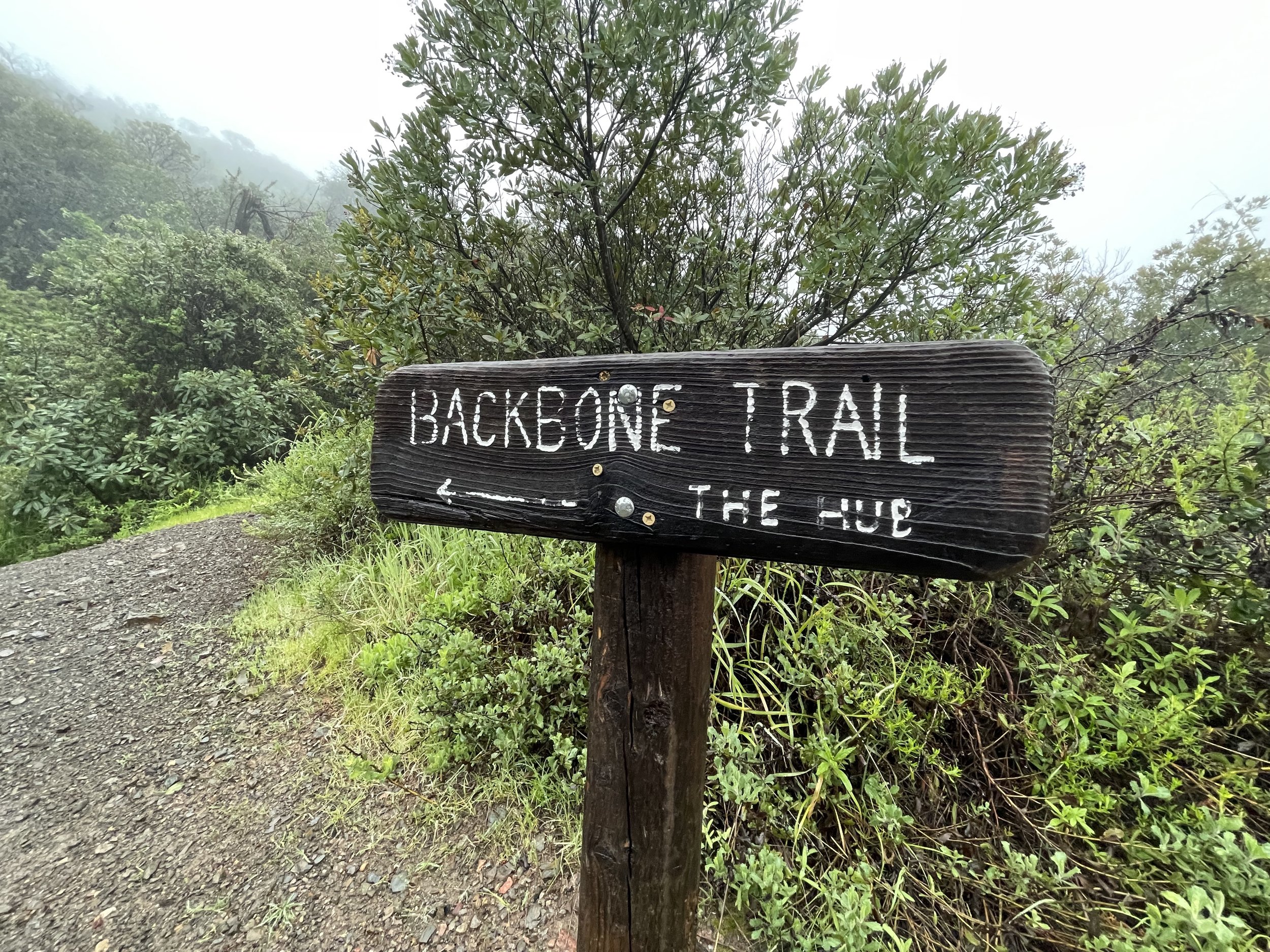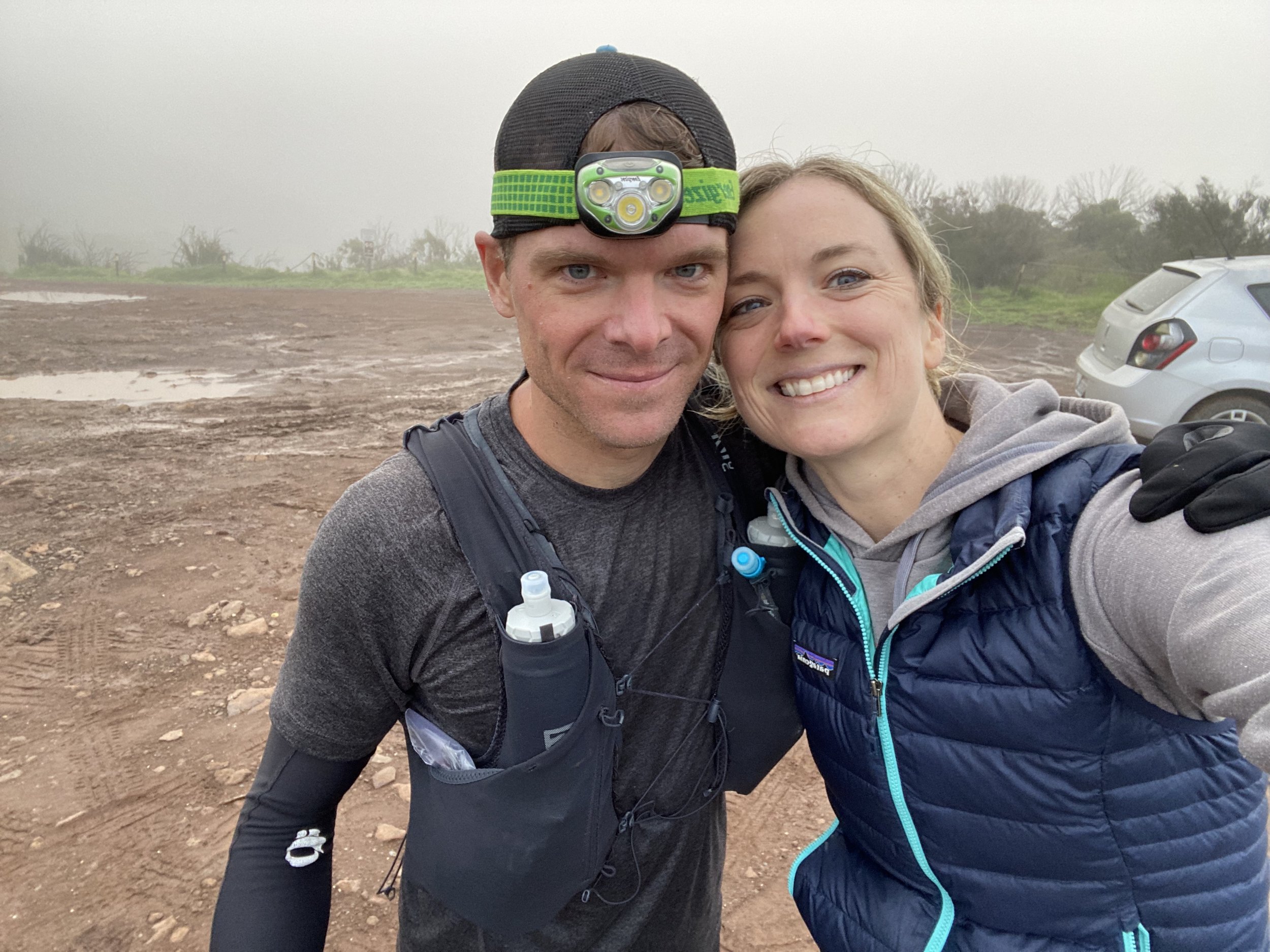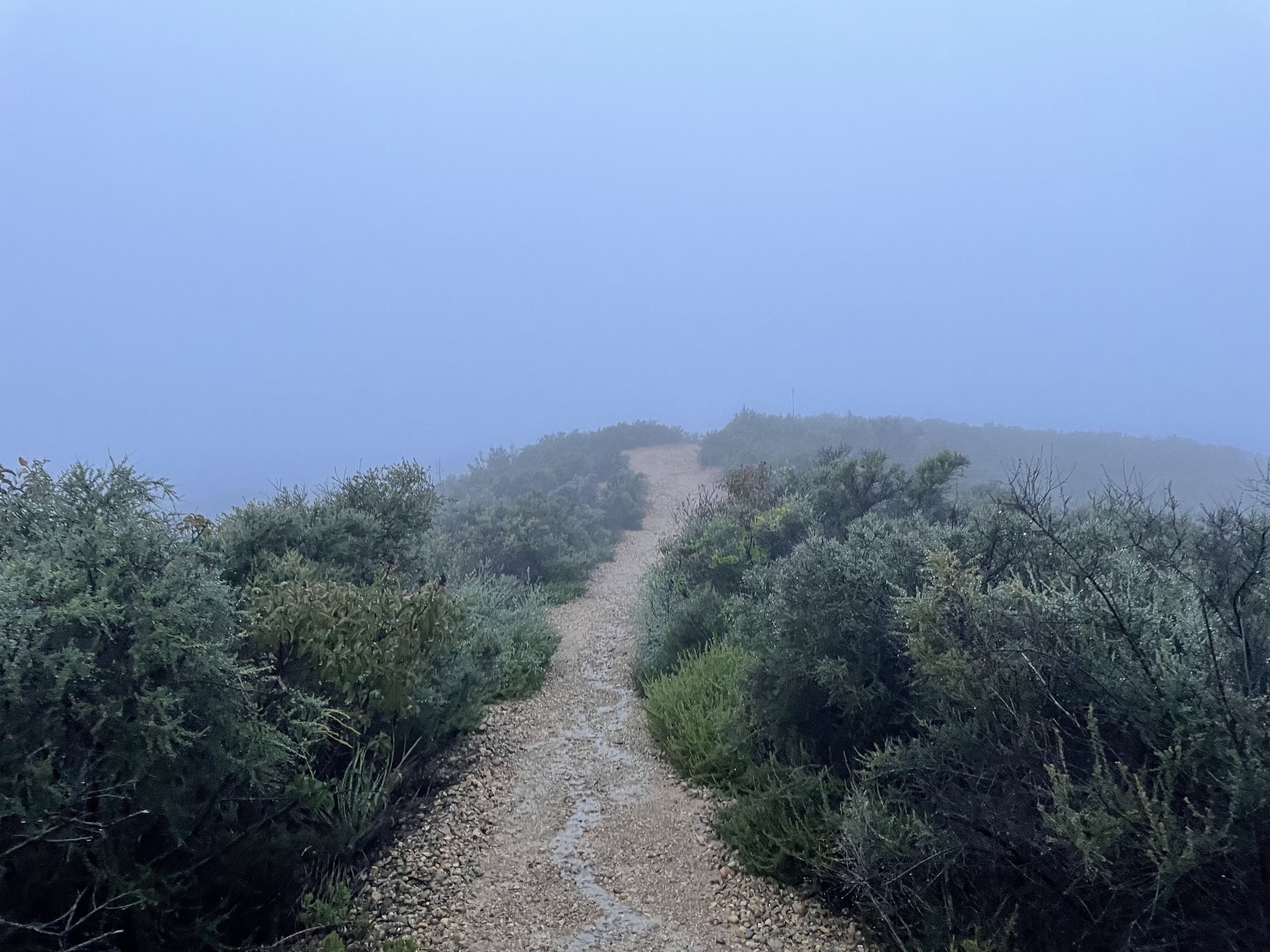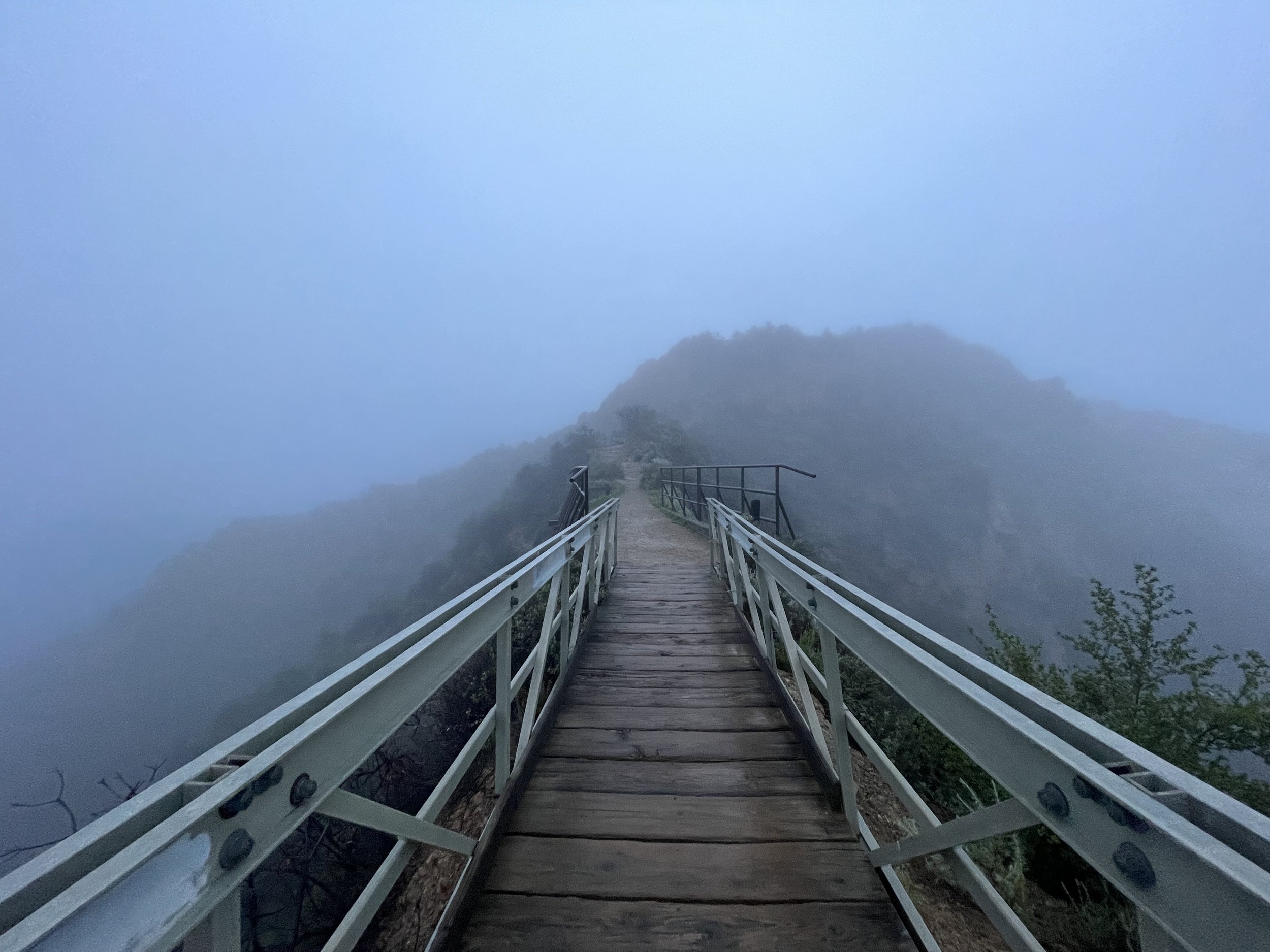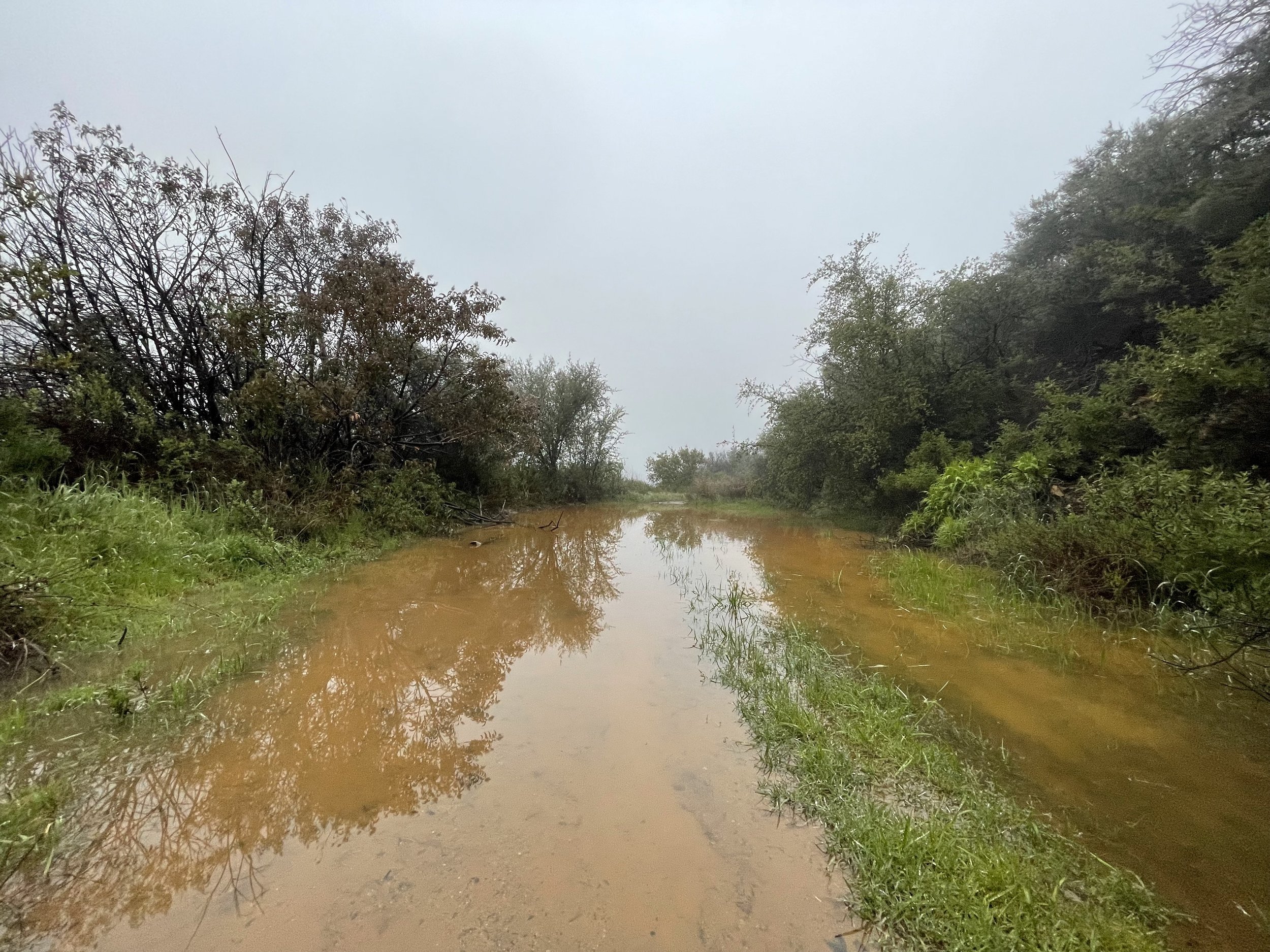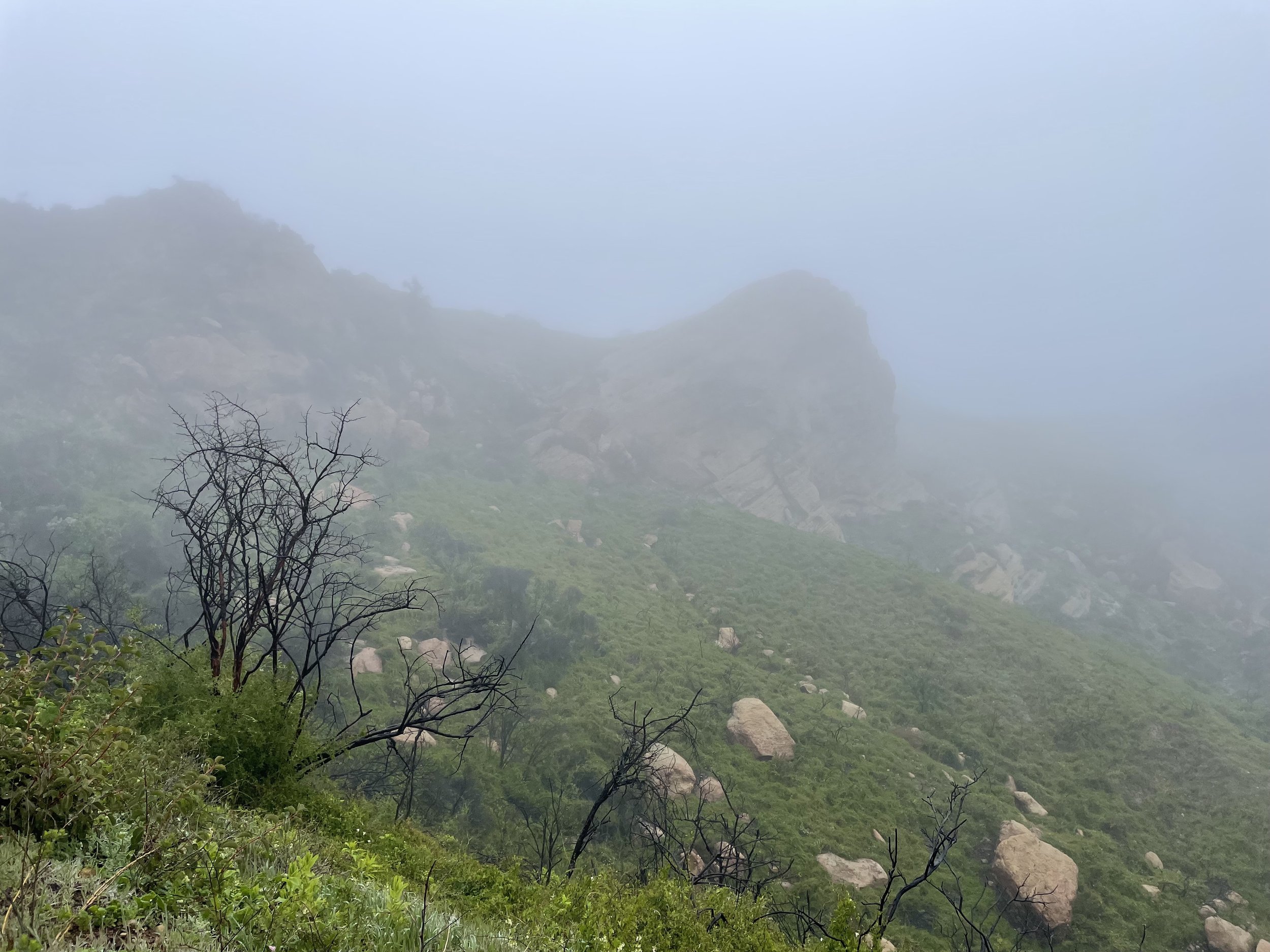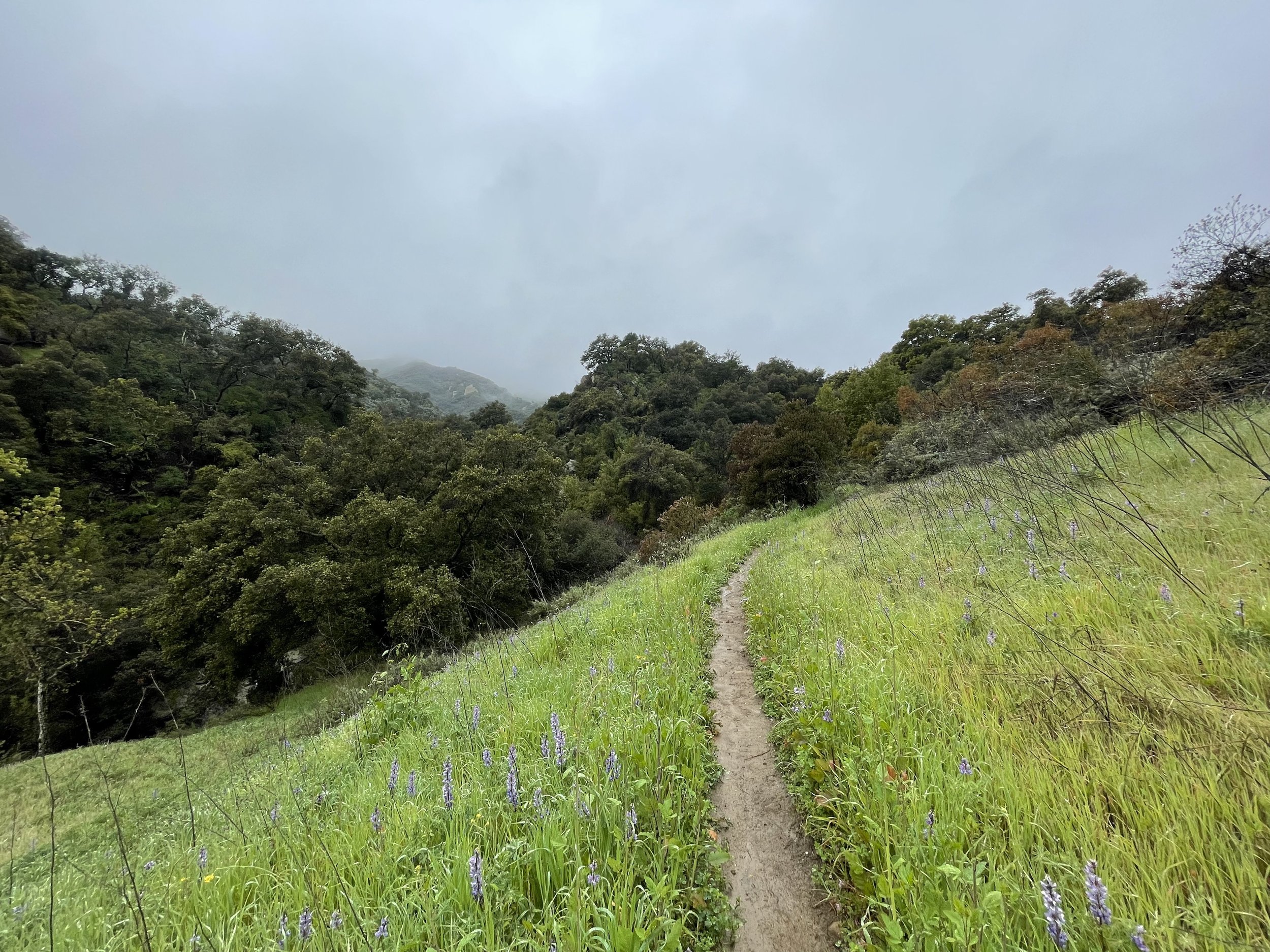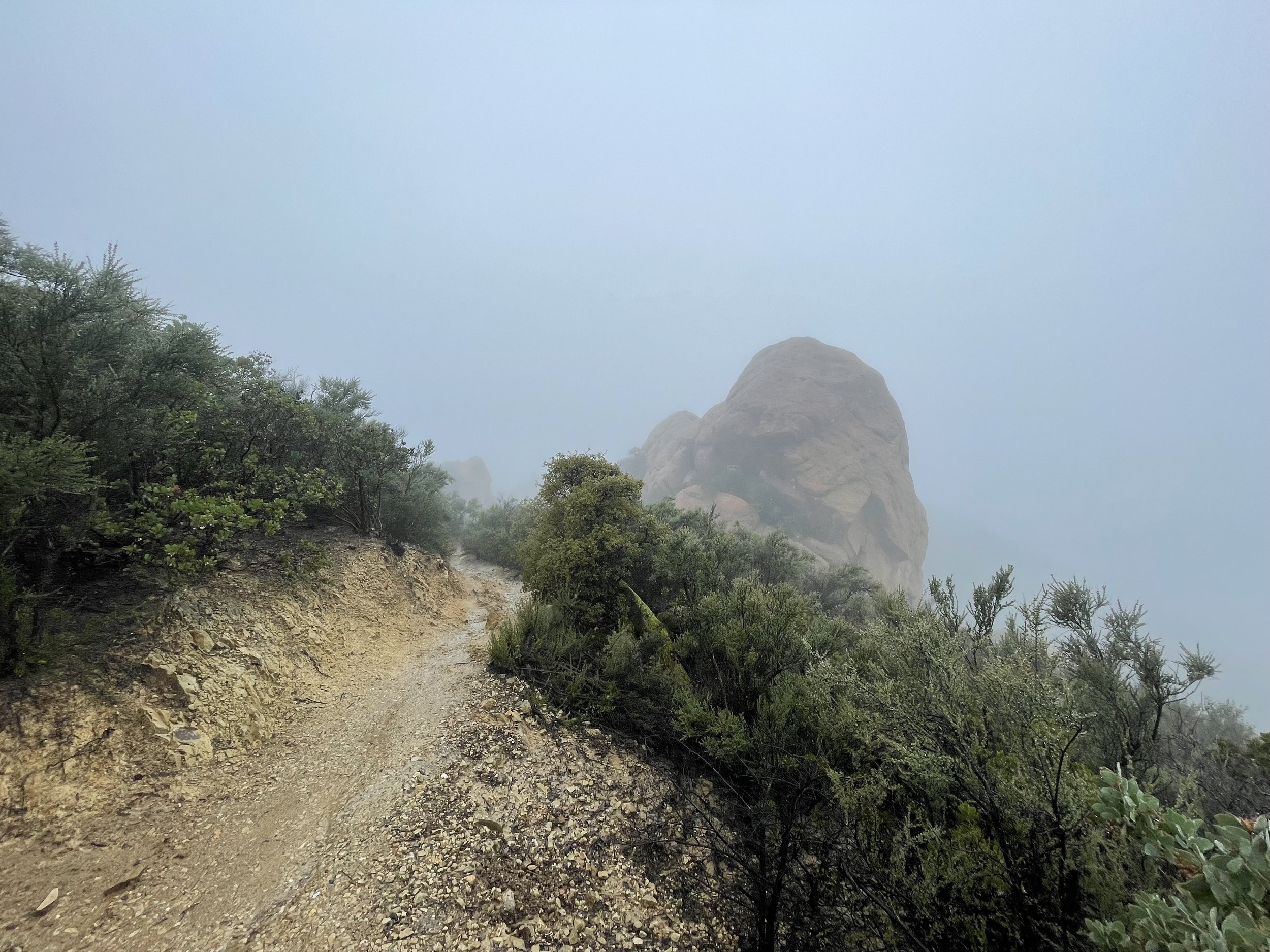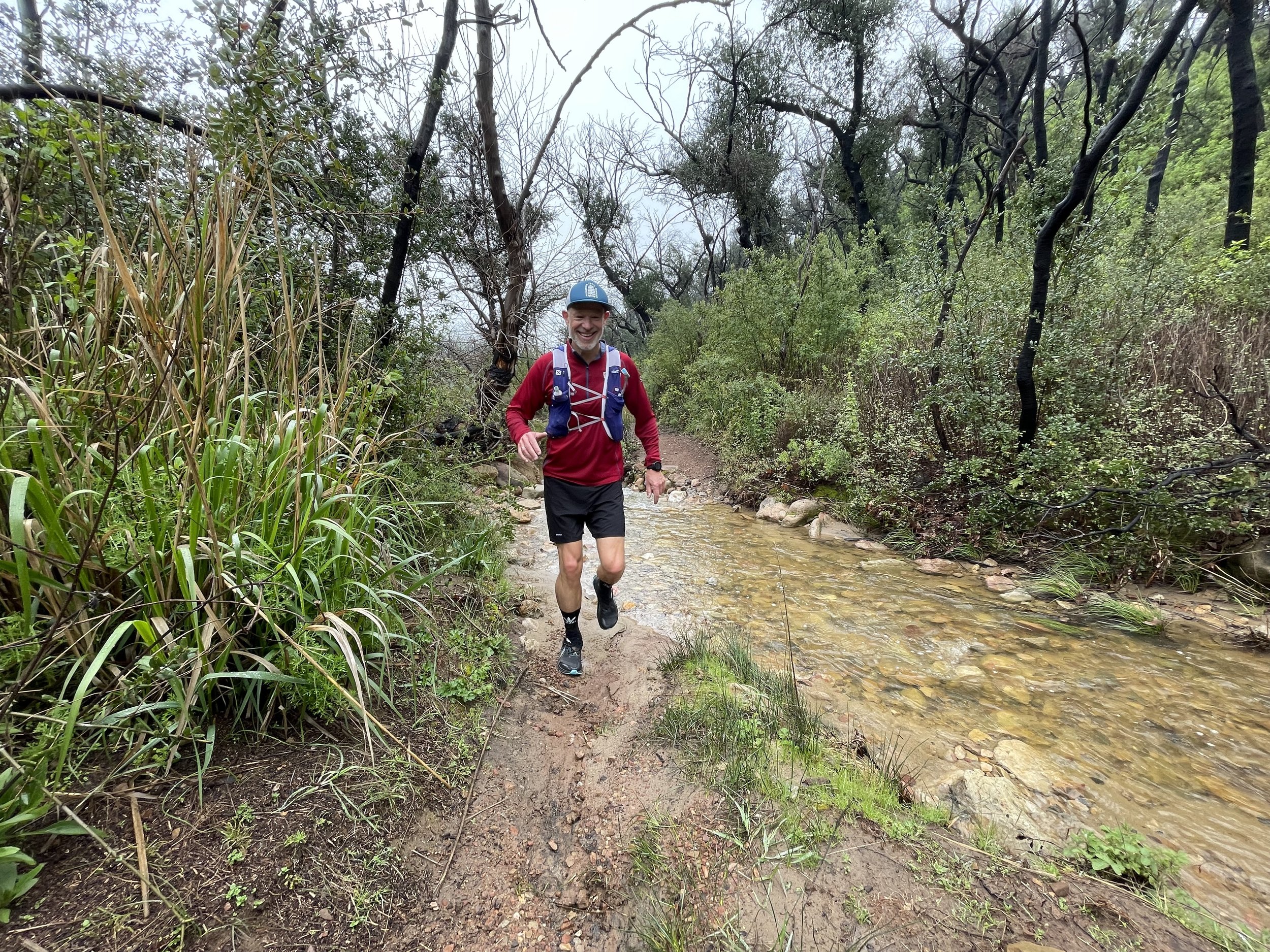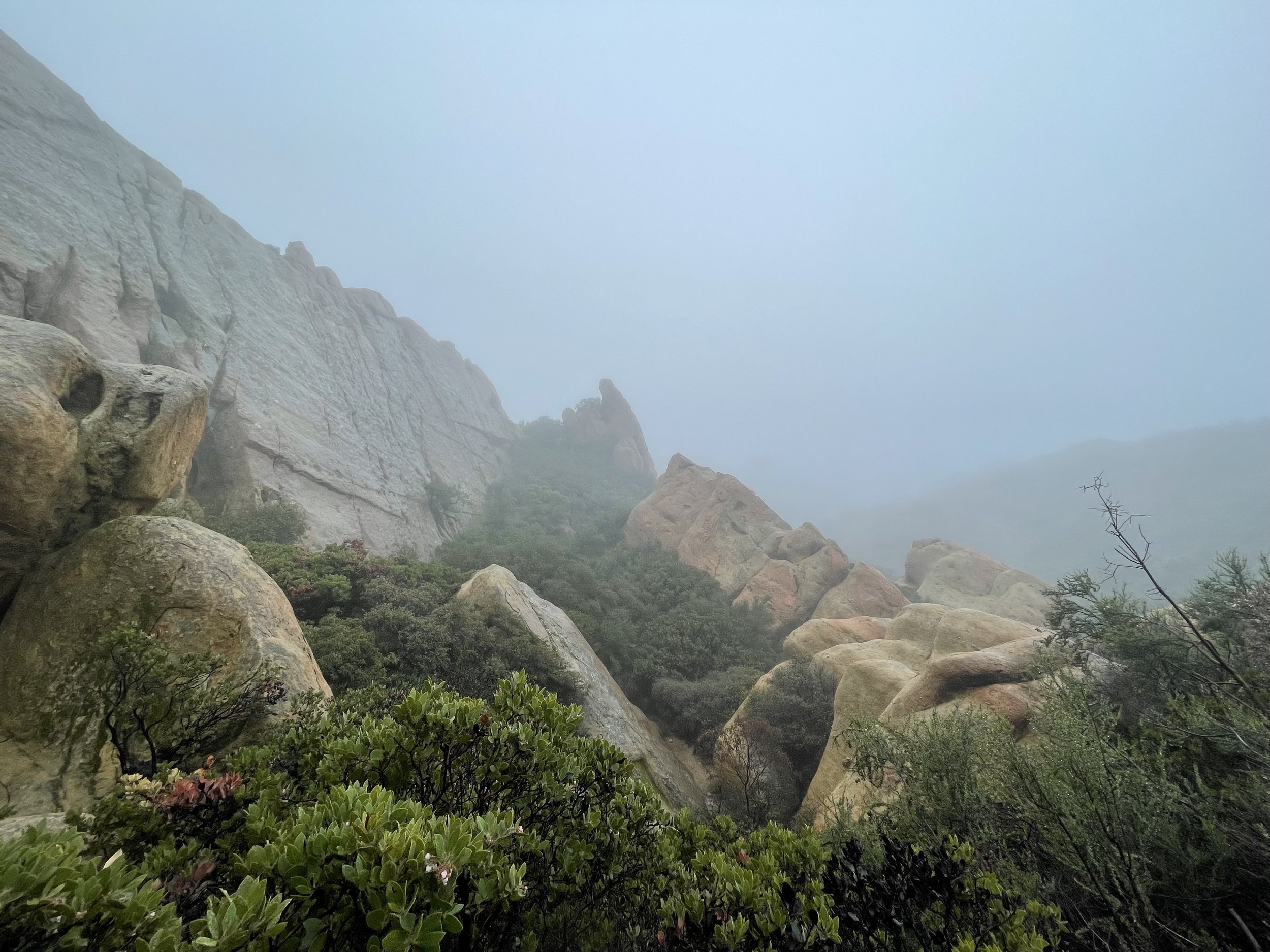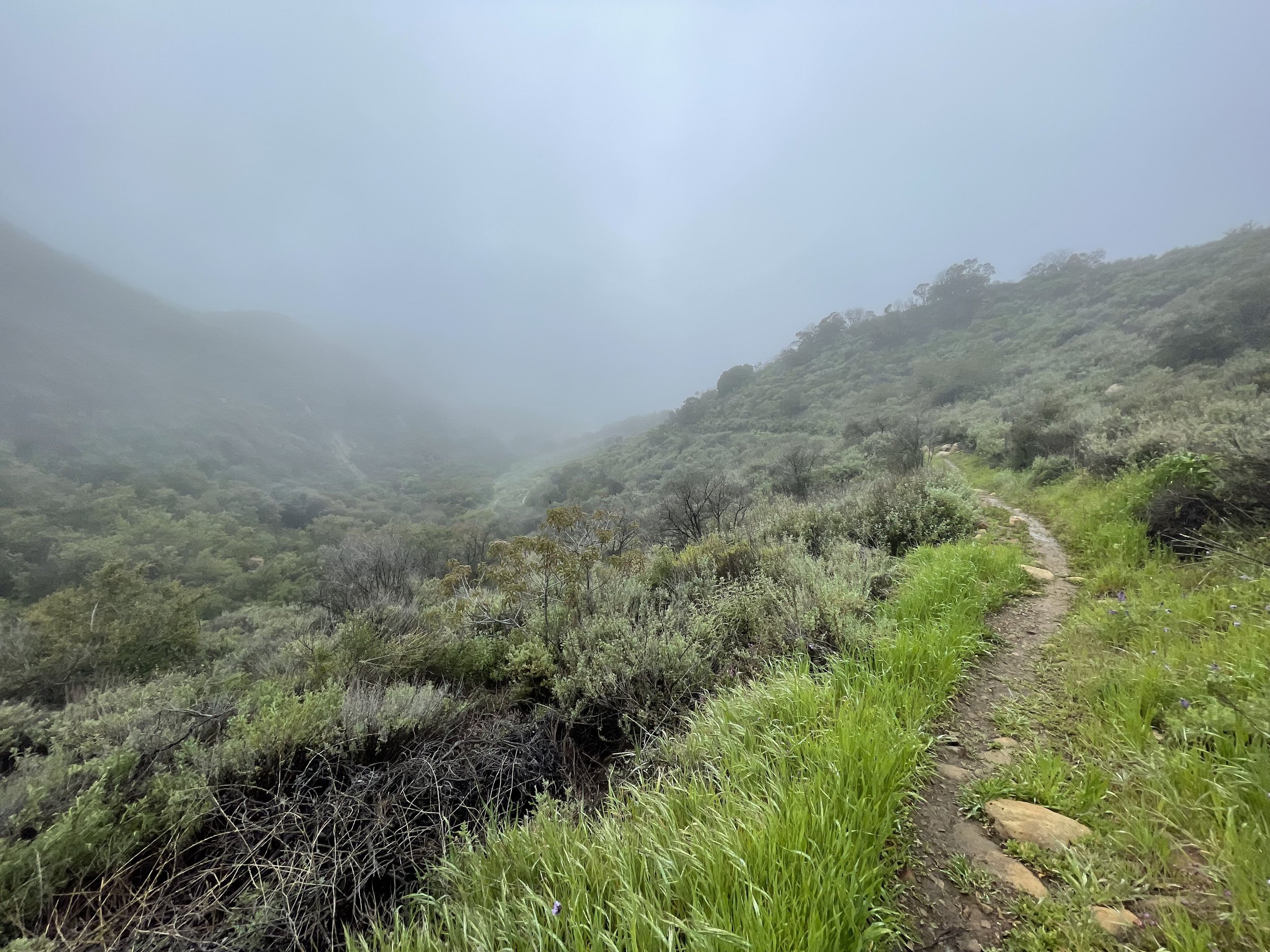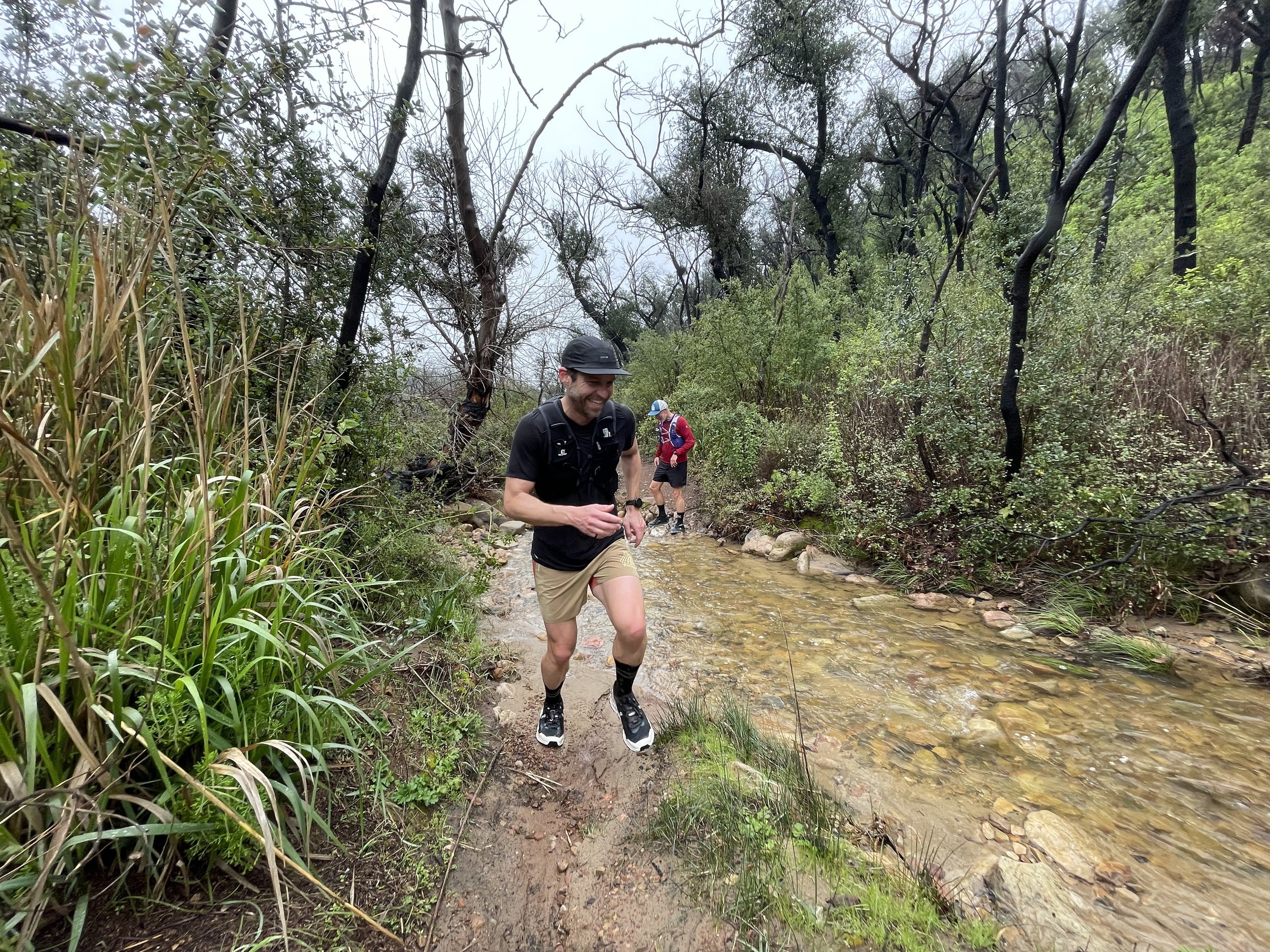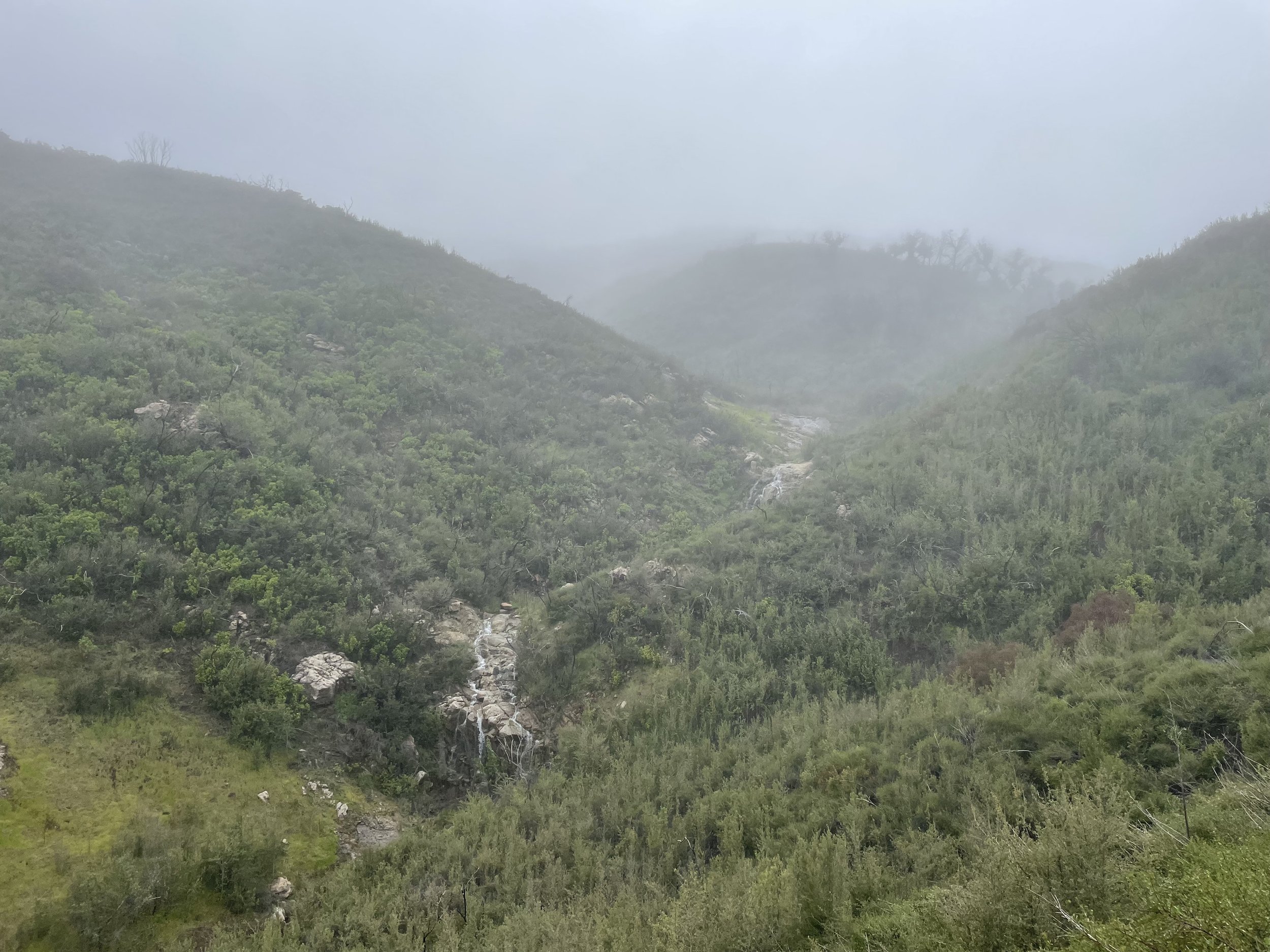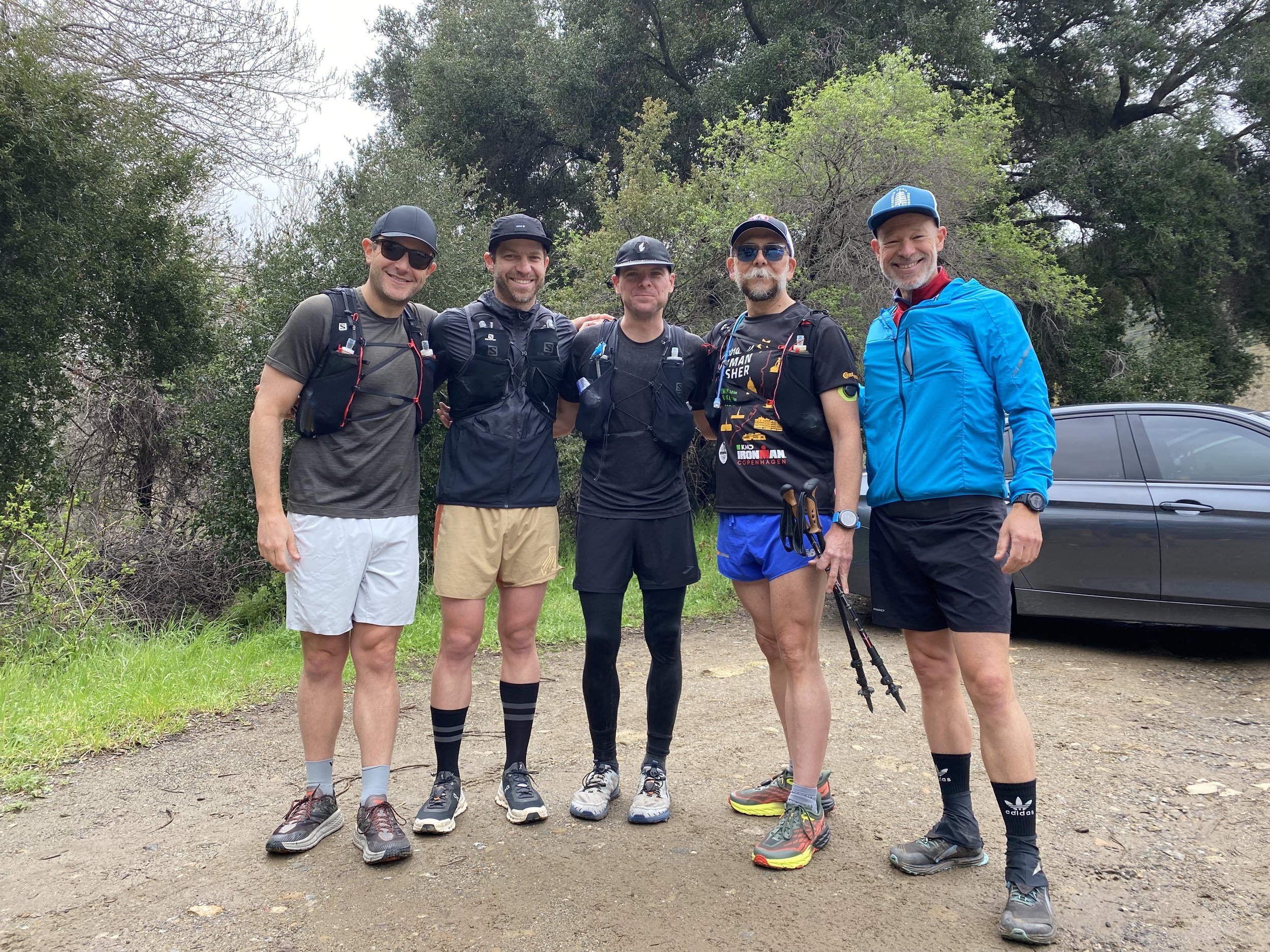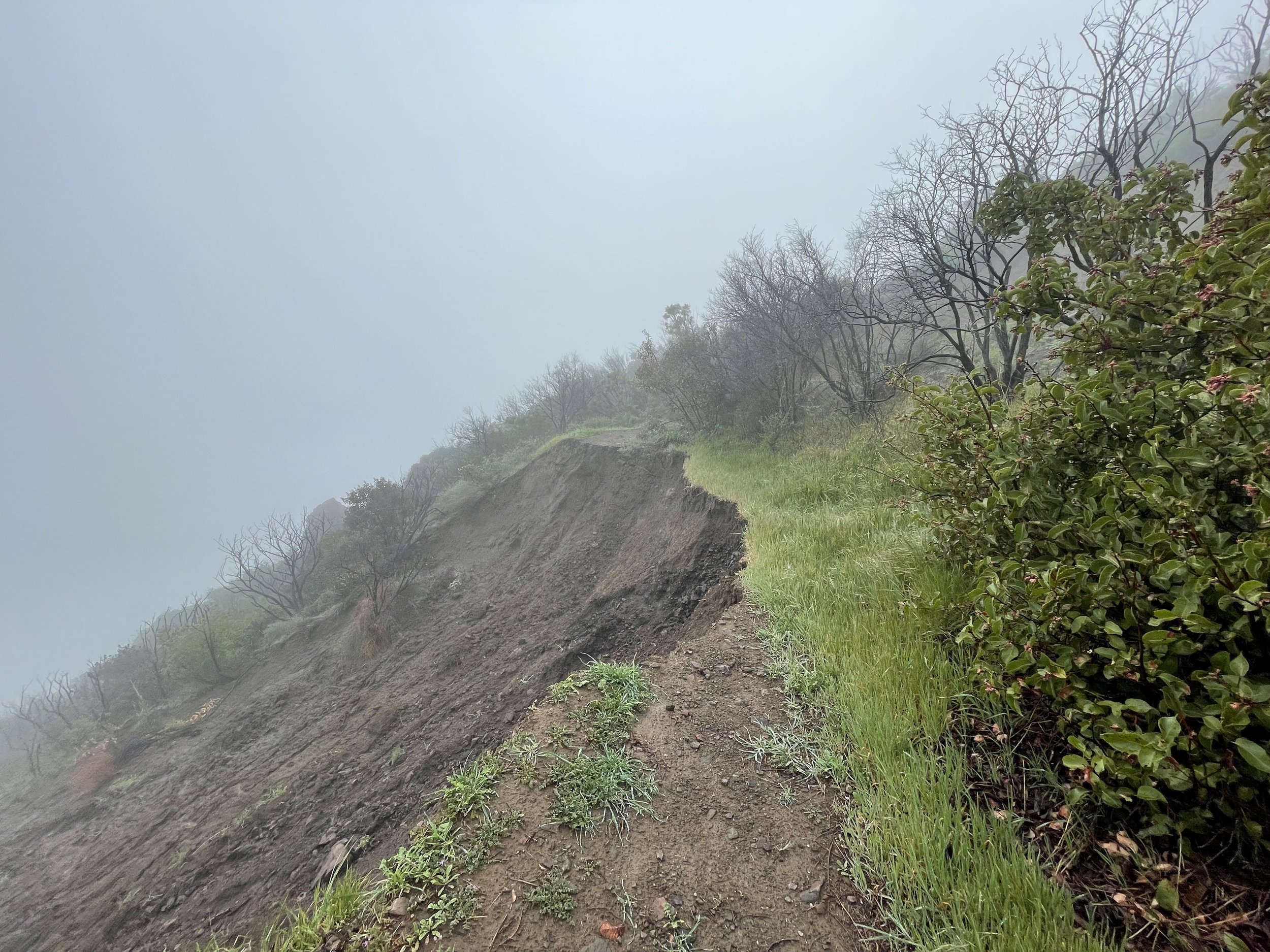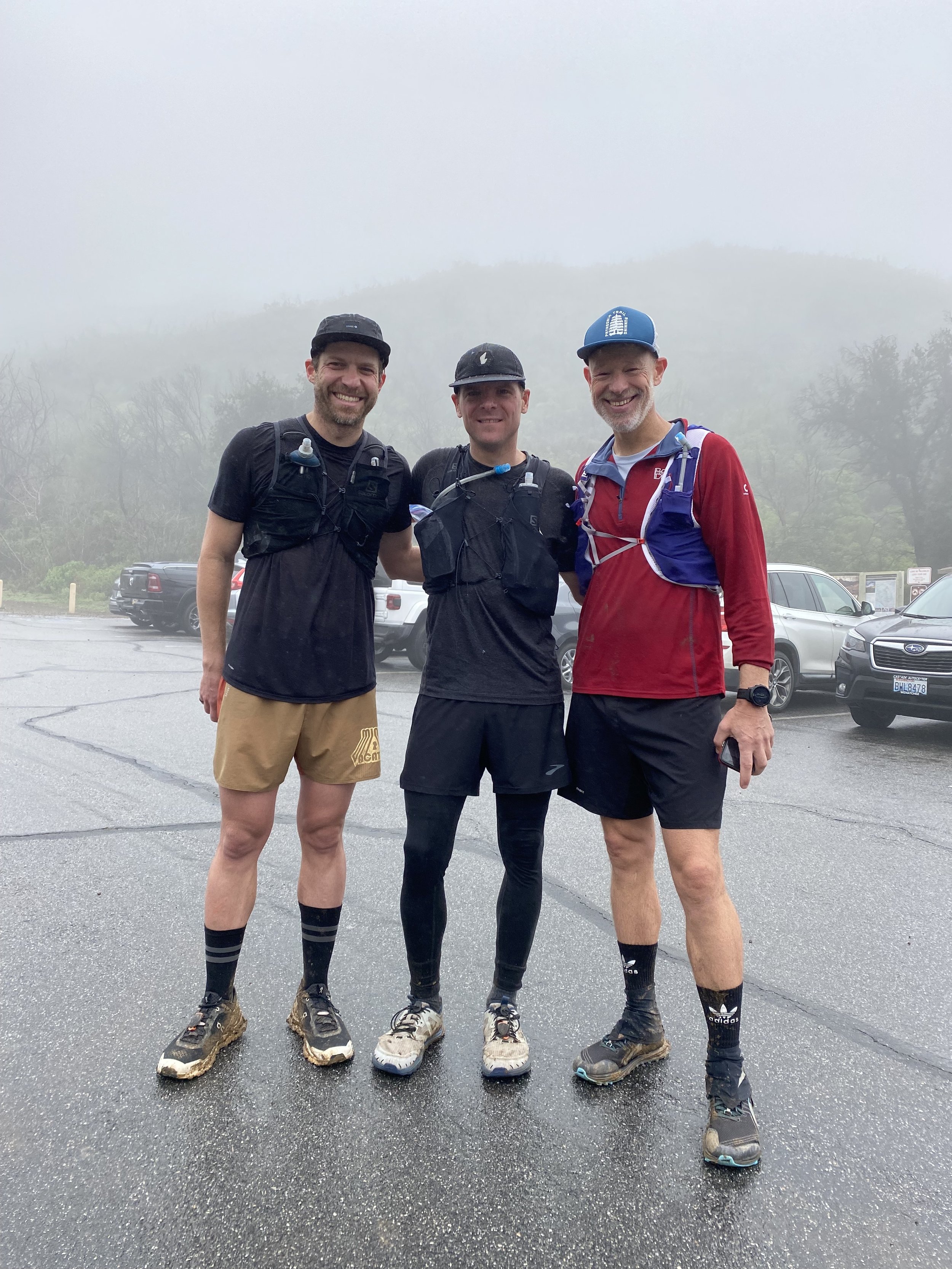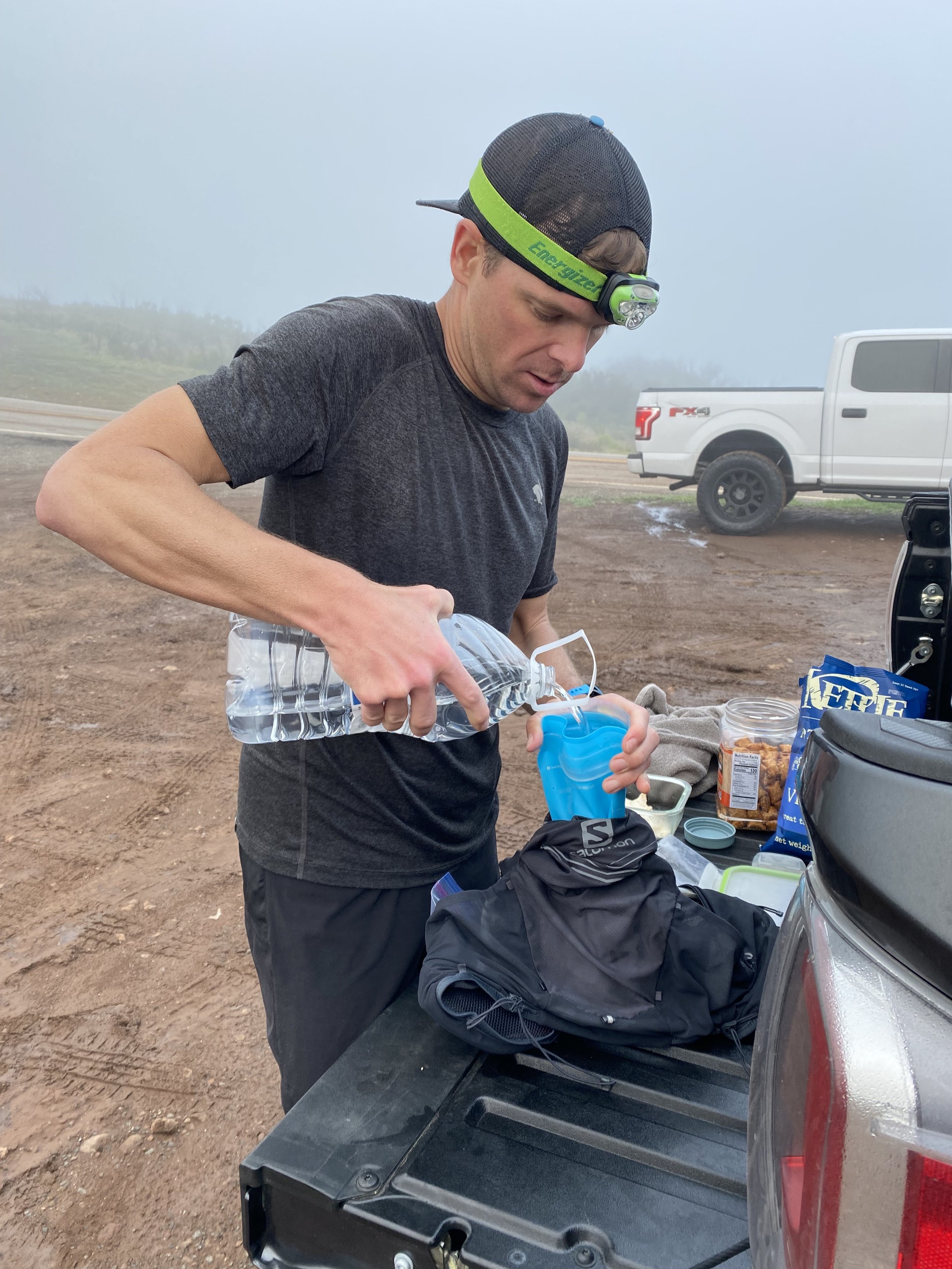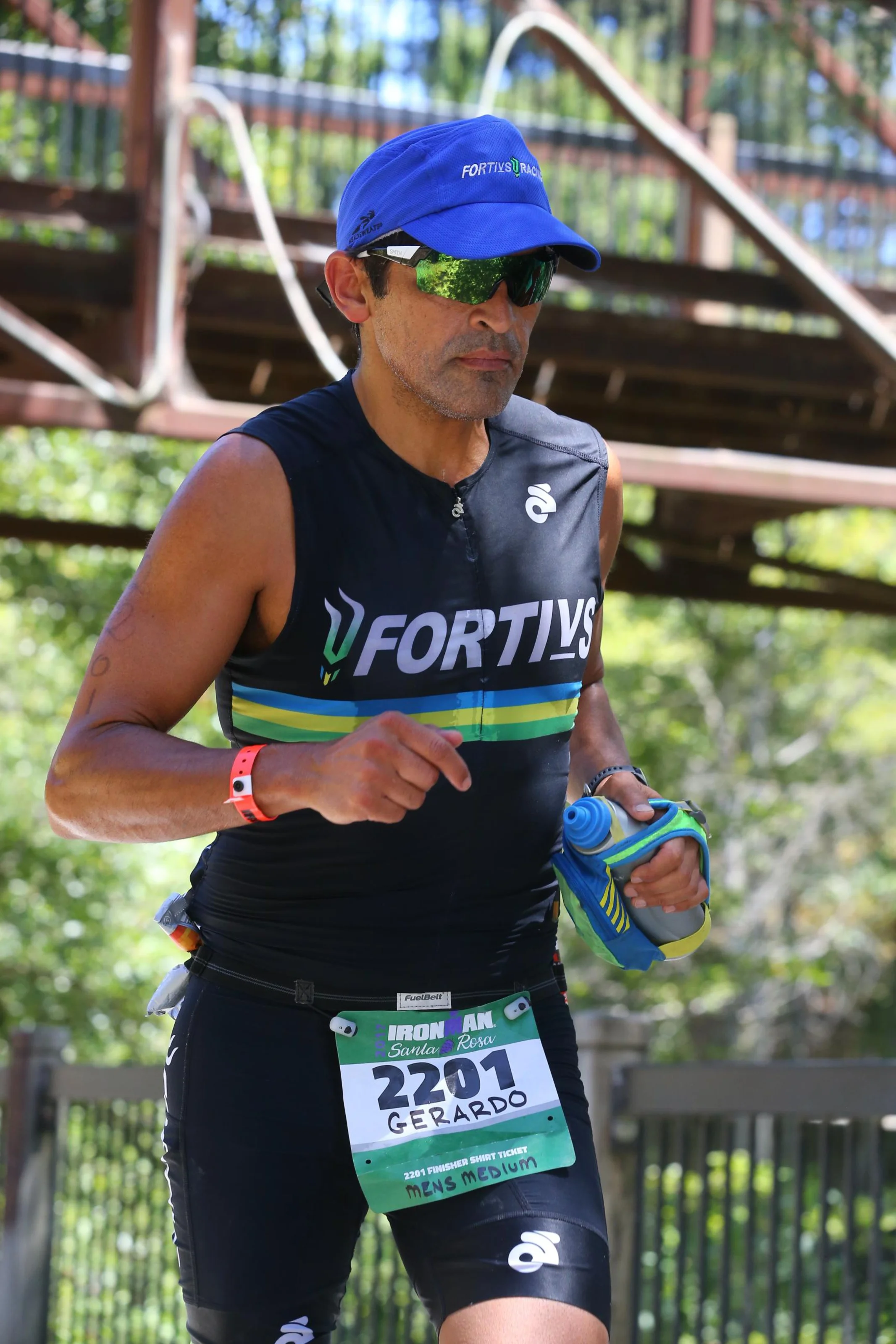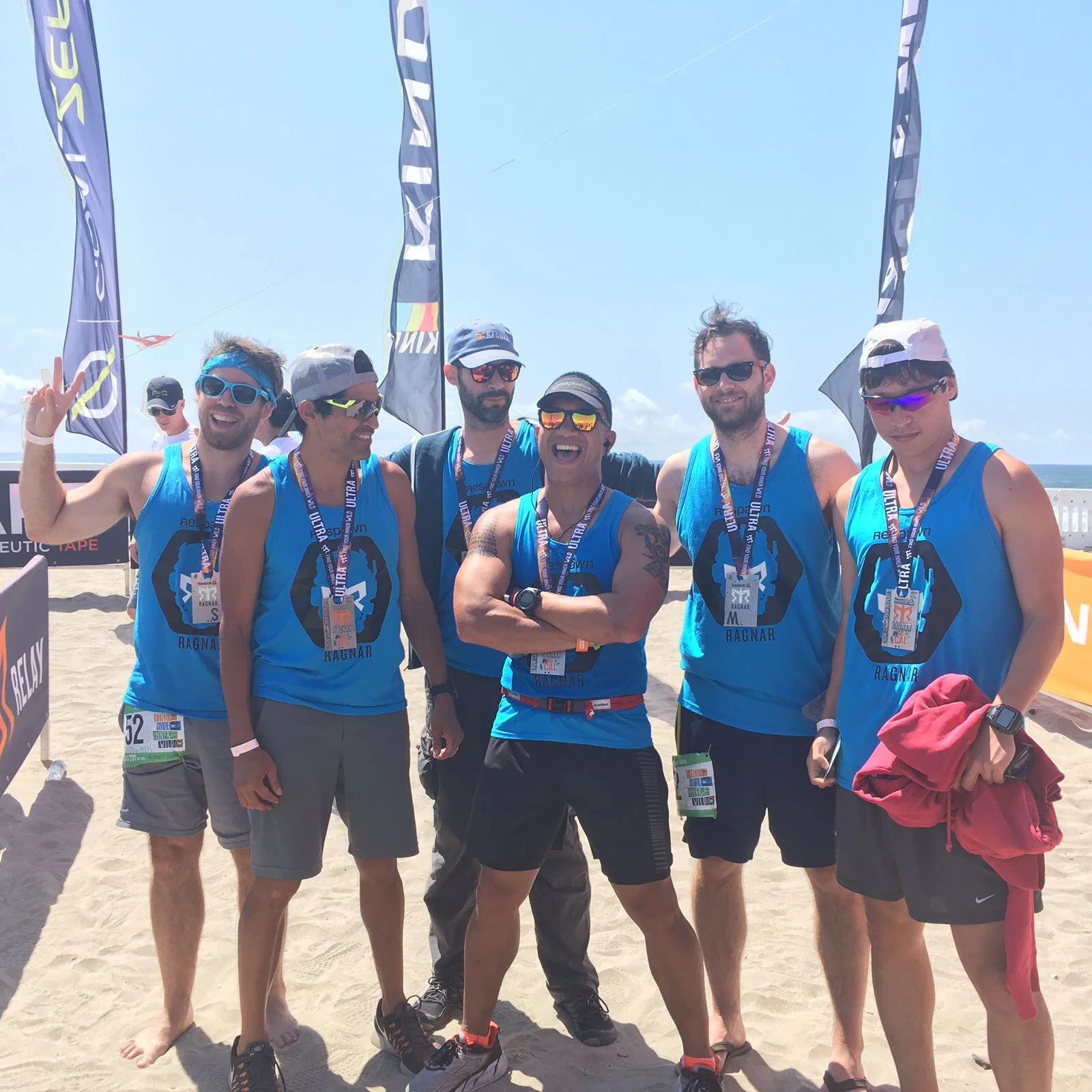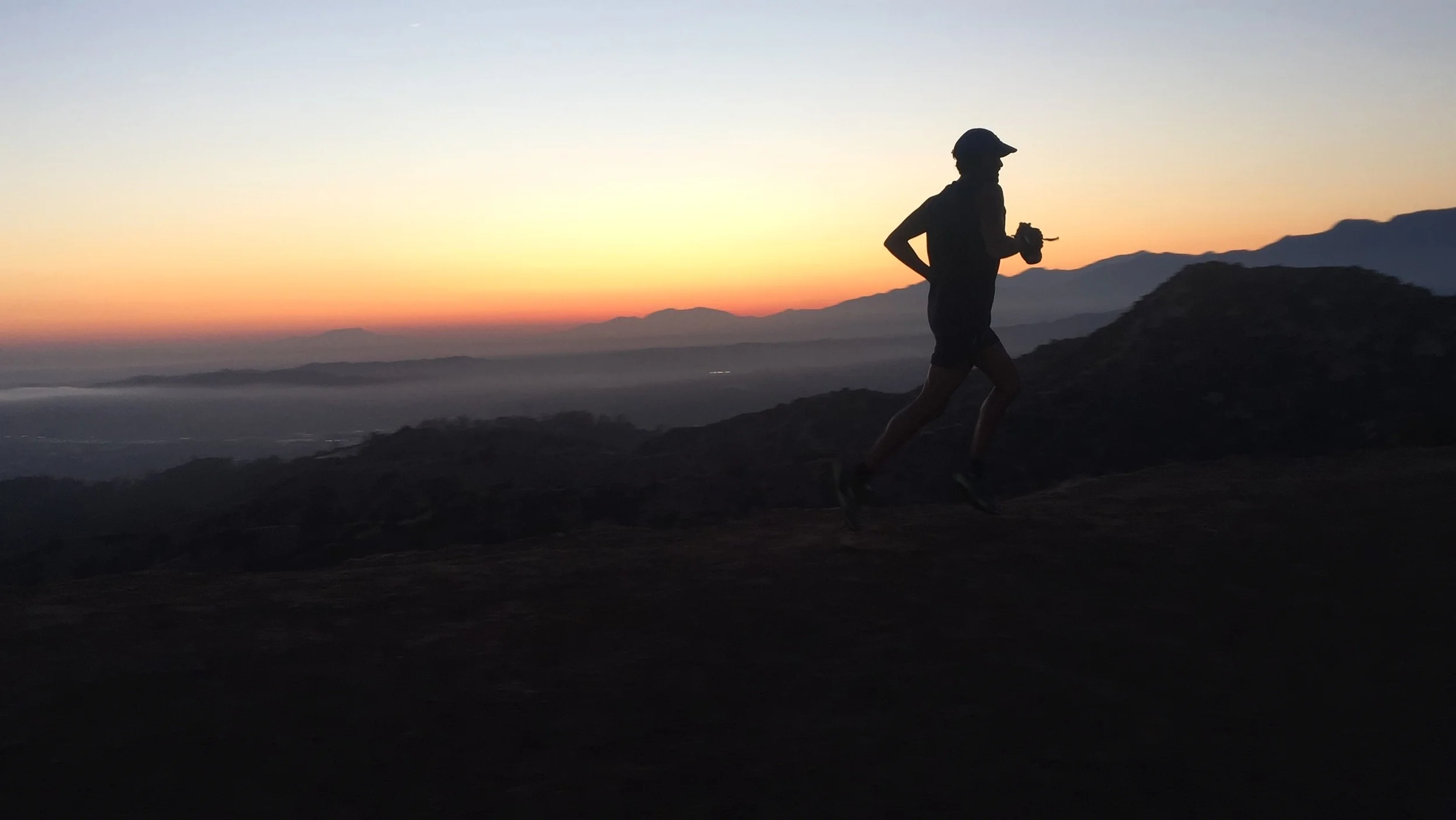
Explore the coach's journal to learn how he and his athletes become better athletes through a consistent training regiment that focuses on process before results.
Dusty's Epic Journey to Redemption on the Treacherous Backbone Trail
“Even with all of that knowledge and awareness of my prior experiences, this was one of the hardest, and quite likely, the hardest physical endeavor of my life!”
Dusty Diller is no stranger to endurance challenges but ultra running events can often throw you curve balls when you least expect it, especially when it’s not part of an official event or race. In 2021, Dusty attempted his first ultra distance event and failed to complete the length of the Backbone Trail in the Santa Monica Mountains. He made one fatal mistake and that was to run every climb over the first 51 miles and when he reached Sandstone Peak, he had nothing left to finish. This winter, he gave himself more time to train and he was ready to tackle it one more time. Unfortunately for Dusty, mother nature has wreaked havoc on the entire trail making most of the train unrunnable due to mud, erosion, swollen creeks and mudslides. Here is his story:
Backbone Trail March 11, 2023
By Dusty Diller
This was my second attempt at running the whole length of the Backbone Trail. The first attempt was in January of 2021. I had made it 51 miles before calling it at the Mishe Mokwa trailhead at Sandstone Peak with 16 miles remaining. It had bothered me for the following months and eventually years that I had not just ‘roughed out’ the last stretch. But I was also reflecting on not finishing when I had not just been running 51 miles, was comfortable, well rested, and not outside at night in the Southern California wilderness. I still knew though, that it continue to haunt me if I did not go back to complete what I started. So with the goal of a redemption BBT finish in mind, Coach Gerardo got me on track (and trails) the months leading up to the March 11, 2023 redemption date.
RACE DAY
I started running around 5:45 am at Will Rogers State Park trailhead. It was lightly drizzling as the day began. Fortunately, there never ended up being any heavy rain at any point, but there was a mist or drizzle on and off throughout the day. The trail had clearly had plenty of recent heavy rain though. There was ample mud throughout the entire route, everything was wet or slick, and there were several water and puddle crossings. This all added an additional challenge to an already difficult endeavor.
Antonya took on the role of SAG and I am greatly appreciative of that. A very long day crewing for someone is an endurance activity in itself. We had 5 aid stations planned. All including; Maurten Gels, Maurten Solids, Skratch Super High-Carb, Clif Bars, Skratch Gummies and other snack / endurance foods. I feel like the Maurten Gels were consistently the easiest thing to get down painlessly during the latter miles when nothing sounded particularly good but knew I had to eat. Skratch Super High-Carb was also perfect for taking in calories when eating seemed like a chore.
At about 25 miles into the run I was grateful to meet up with Erik, Enrique, Mike, and Spencer who paced me from Piuma / Las Virgenes to Kanan Dume. So nice to have them as moral support and to push me as well. I had done several training runs with Enrique, Erik, and Gerardo leading up to the event and I appreciated and enjoyed all of those runs but also gave me the insight I needed on how to approach running each segment of the 68 mile trek. Great friends, strong athletes, and training buddies.
There were of course beautiful views throughout the whole day and even under the strenuous circumstances, I was able to appreciate them up until the end. The mist texturing the surrounding wilderness gave off a very surreal and eerie vibe. But I really liked that even in the solitude of my journey.
Mike kindly let me take his trekking poles which I was EXTREMELY glad to have for the last 16 mile stretch from Sandstone Peak to the finish. They were incredibly helpful to climb muddy hills and just helpful to have the additional points of ground contact. And by the end when I was basically shuffling along, they were borderline crutches. It was something I greatly regretted not bringing along from the start.
I made a massive error in being overconfident with navigation for the section of the trail I had done the least, which was from Sandstone Peak to the finish. It was dark by the time I was doing this section, so I could not see without a headlamp, and the prevalent mist was being reflected off my light which made visibility even worse. Once I reached Danielson Ranch, I started heading down what I thought was the fire / access road that would link up to the next stretch of BBT single track. I was in fact going the opposite direction. It was very disorienting, especially being so dark and for how tired I was. I was second guessing whether I should continue down that route and thinking it could possibly still be correct. I ended up (painfully) backtracking to Danielson Ranch to reassess. Fortunately I ended up finding a map at the ranch to confirm where I should go, which was, in fact, not the way I had initially gone. I had almost gone down an additional fire road thinking that it would take me to the trail, but looking on a map later, it would have only made the situation worse.
The whole run took 17 hours. I had been aiming to do sub 14. Coach and I even set out to run the trail using Stryd power to help me pace and gauge my effort. From the beginning I knew it was going to be futile to attempt to run much of the course with so much damage to the trails. On top of this I’m sure without the detour and time spent re-calibrating myself at Danielson Ranch and under dry conditions I could at least get closer to that mark... but instead of speculating I suppose there's only one way to find out. The total mileage ended up being 72.5. It should have been 68 but getting lost tacked on the additional miles.
I had thru-hiking experience going into this including the full Pacific Crest Trail, Continental Divide Trail (with still a few Montana miles to finish), and the full Colorado Trail. The time spent on top of cold, rainy or snowy mountains with no option but to move forward no matter how much light there was or what the weather was doing was helpful during this adventure. Of course the prior attempt, a full Ironman and 4 Ironman 70.3 events were valuable experiences to bring as well. Even with all of that knowledge and awareness of my prior experiences, this was one of the hardest, and quite likely, the hardest physical endeavor of my life! Even under such difficult conditions, it was an awesome adventure and I am very glad to have done it. There is still a part of me that wants to try again under dry circumstances and without the navigation blunder.
Now I’ll start getting ready for Ironman Victoria 70.3 and the Ironman Mont-Tremblant full later this summer. I will certainly be able to take lessons from this feat into both events. Even if it’s just the mindset of ‘well, at least it’s not muddy’. A definite part of the joy in endurance activities is seeing what you are capable of through experimentation with distance, conditions, and disciplines. And they all offer a slightly different flavor of feeling and headspace you venture into.
I was happy overall with how the nutrition went. As mentioned, the Maurten Gels were the easiest thing to regularly get down. I would take those about every 20 - 30 minutes with the occasional caffeinated gel. I was sipping on Skratch Super High-Carb the whole time and would add Skratch Gummies or a Maurten Solid here and there. I was roughly trying to take in 300 calories per hour and never did hit a ‘bonking’ point. The slowness (aside from the mud) especially in the later miles was due to general muscle and joint soreness and fatigue. I had two Red Bulls throughout the whole run and also had peanut butter and jelly tortilla ‘quesadillas’ which were pretty nice. For the next event like this, I’ll 100% add cold watermelon to the aid station menu. I maintained a full back reservoir and was sipping water regularly.
Thank you to Coach Gerardo for the excellent guidance and getting me to the point to be able to finish this thing. Thank you Antonya for crewing the whole thing. Thank you to Erik and Enrique for joining me on all the training runs and for the pacing. Thank you Mike and Spencer for pacing and showing up on the day. And thank you for all the support from everyone.
Notes for the next similar adventure:
Have an external battery to be able to keep the phone charged.
Have a viewable and detailed offline map of the route.
Bring trekking poles to carry or have at aid stations.
Carry spare headlamp batteries and possibly a handheld flashlight.
Have extra socks at aid stations (even though would not have helped this day).
Cold watermelon at aid stations.
Ironman Lake Tahoe 2013: Lessons in Mental Strength
In 2013, I did everything possible to prepare for what would eventually be the most epic Ironman adventure I would be a part of. The lessons learned in Ironman Lake Tahoe would propel me to achieve many things in endurance sports that I set out to do.
Ironman Copenhagen: Race Report, Planning for Success
At the end of the final loop I was anxious to get it over with so I picked up my pace and to my surprise it was still comfortable. The crowd and thinned out and many people were walking. I could hear the Ironman announcer as I made my way down the street before making the left turn towards the chute.
As a coach part of my job is to provide the athlete with a complete picture of how to prepare for events to includes long-term planning, short term objectives and measurable goals. Each workout is designed to get to the finish line strong. Mike just completed his first Ironman in Copenhagen and his patience with the process during his 3 year plan culminated in a successful event. Here is his full report:
IM Copenhagen 2019 Race Report:
By Mike Roybal
First, I want to thank my wife and son for putting up with all the gear I have bought (and mostly used), the absences from home, and most of all for supporting and loving me throughout the process. Next, I want to thank all my Fortius Teammates. I have learned so much from each and everyone of you. Whether you know if or not I’ve been listening to everything you have said or told me and used your experience, knowledge, kindness and grace as my inspiration to do be able to complete my Ironman. Last, but never least, I want thank Coach G—your coaching and support have made it possible for me to accomplish my first Ironman and I could have never done this without you and the Fortius family you have assembled around me. It is a testament to you that my teammates are the most supportive people I know. A special shout out to Enrique Marquez Paris who was my Copenhagen training partner (I especially appreciate his patients in putting up with an old man 20 years his senior) and Adrian Vasquez who planned on racing with us and I know will join us as an Ironman in the near future.
Let’s start at the beginning...
I started doing Triathlon the summer of 2016 when my gym offered a training opportunity for the Malibu Classic and Olympic Triathlons. Adrian Vasquez and and other friend from spin class had signed up—I was looking for a challenge. I had only cycled in spin class, which I enjoyed, but I hadn’t ever swum or run for exercise. I completed the Malibu Classic Distance, but the thought of a full Ironman distance never crossed my mind. Adrian and I did the Olympic distance next and heck, since the Half IM was double the Olympic, why not do it? Right? That led to several Half IM’s and since a full was only double the half and I could do a half, the IM seemed the logical next step. Copenhagen, with cool weather, a flat fast course, and atmosphere seemed the best destination IM especially since I would be doing it with a teammate.
My family and I arrived in Europe 8 days before the race, starting in Rome. My son wanted to go to Italy to eat pasta, so we figured it would be a great way to carb load. It was hot and humid in Rome for the 4 days we were there. I ran once, got lost, but mostly focused on nutrition, hydration, getting used to the time change and resting. There is a 9 hour time difference between LA and Rome/Copenhagen, so I would definitely plan on arriving at least 4-5 days before the race to acclimate for anything more than 6 hours difference. There were several mornings where I woke up at 0200-0300 with 3-4 hours of sleep and could not fall asleep again. I don’t know what they call siesta in Italy, but I did that really well to make up the difference. We did some walking and sight seeing as well in the morning and early evening due to the heat.
We arrived in Copenhagen 5 days before the race. The weather was forecasted to be cloudy with showers all week until and after race day. Enrique and I did one shake out ride the day after we arrived. During the ride a new chain I had installed before leaving, but did not test, broke less than a mile into the ride. I should have taken the bike out for a spin to make sure everything was ok before leaving. Fortunately, I was in one of the bicycling capitals of the world where there’s a bicycle shop every 20 meters. The chain had lodged between my wheel and the street and the busted link was damaged. The very nice shop owner fixed the chain, but had to shorten it such that I could not use the big wheel and the low gear. He ordered a new chain which would arrive the next day. We finished the ride and then did a run through a cemetery where Hans Christian Andersen and Kierkegaard are buried across the street from our AirBnB. I went by picked up the next day and he installed it. It rained riding to and back from the bike shop, it was then I decided that if it were to rain on the ride, I would need to wear breathable gear to keep me warm and dry. When it rained, it was always windy as well. Although that didn’t phase the Copenhagians(?). They ate on their bikes, texted, smoked, talked on the phone, held hands, and kissed rain or shine, wind or not. It was awesome.
We picked up our race packages in Copenhagen at the BLOX building three days before the race. (BLOX is an architecture, design, construction and tech institute working to develop new sustainable urban solutions—and they have an awesome Lego room.) The Expo was located here as well. The T1 was at the swim located about 3 miles away at the Amagerstrand and the T2 was located at the Bank of Denmark, a few blocks from the BLOX building. The finish line was in front of the Danish Parliament at Christiansborg Castle a few blocks from T2. All of these separate sites were a little confusing and a change from the events I had done before.
My pre-race plan was the following: I would hydrate, carbohydrate load and limit walking, milk products and fiber rich foods for the three days before the race as much as possible. That necessitated taking cabs to many places which gets expensive. The trip to the Amagerstrand to drop off the bikes was in the $60 range each way. Luckily, Enrique and I could split the costs of the cab rides. Renting a car was not practical as parking is only on the street and metered.
The day before the race we needed to drop off our bikes and Bike and Run Transition bags. For the Bike Bag I decided to wear my Fortius vest, arm warmers and Balega ultra run socks with mohair. The clothes chosen would keep me dry, warm, breath and, except for the socks, could be removed if it did get warm. I choose to use the technical pink photo-chromatic lenses in my Rudy glasses for the ride/run and packed them as well in my Bike Bag. I included a spare tire which I could put in my back pocket. The Run Bag contained my new Hoka One One Clifton road shoes (I know, I had only used them a couple of times, but they seemed to work well with no knee issues after running), my race belt with number, extra Balega socks, a running shell I bought in case it was cold and rainy, my Fortius Technical Trucker run hat, and my Nathan collapsable run bottle with 16 oz of Carbopro + Fluid (200 Calories), two tubes of Base Salt, and 6 gels with extra sodium 90 calories each. I made sure to close the bags well as it had been raining off and on. We had tried the sponsor electrolyte drink which was promoted as isotonic (same salinity as blood plasma, less likely to cause stomach upset), which tasted like Tang for those of you who grew up in the 1970s, not bad really, so I knew I could use it on the bike if needed and definitely on the run.
I only used the bike special needs bag. I placed 48 oz of Carbopro + Fluid in a used 2 liter water bottle (400 cal per 24 oz) which I could refill my bottles with. In addition, I also placed an extra CO2 and tire as well as 800 mg of ibuprofen that I could take either during the bike or save for the run if I needed it.
I would take three 24 oz bottles each with Carbopro + Fluid (400 calories/24 oz) as well as my full Torpedo hydration bottle with the same mixture on the bike. I would refill my Torpedo with the three bottles I had on the bike and then on the second loop refill the torpedo and another bottle with my special needs bag fluids.
Race Day:
We awoke at 0400 and ate a breakfast of 3 eggs, a cup of white rice, half a banana and 1 cup of Picky Bites maple apple oatmeal. I had an 8oz cup of coffee (Danish coffee, its ok) as well and started drinking 24oz of Fluid without Carbopro. I was able to drop the kids off at the pool without any problem (thank you coffee). I took another banana with me and a Cliff Bar with nut butter for 1 hour before my wave start time of 0730. I checked my urine and it was nice and clear and colorless meaning I was adequately hydrated. We jumped in a cab at 0500 and arrived at 0520. We checked in the Special Needs bag, I ate my banana and cliff bar and finished off the rest of the Fluid I had brought. The weather report that morning was for no rain until the early afternoon. The sun rose and broke through the clouds. Our fear of a rainy, windy bike ride did not seem to be materializing and rain later in the day during the run would be most welcome! We changed into our wet suits dropped off our street clothes bag and headed over to do a warm up swim at 0650. The water was just right, about 64 degrees. I lost Enrique after that as he was going in the first wave of red cap swimmers.
I would seed myself in the 1:11:00 to 1:17:00 wave of pink capped racers. This equated to a swim pace of 1:47/100yds. The swim course started with a right turn at the first buoy and all left turns until the last buoy, passing under two bridges with green balloons tied to the railings and the red Ironman logo as well as large white numbers marking the distance swum in 600 m increments going out and back. There was a power plant with smokestacks in the distance on the first half headed north which also assisted with sighting after the second bridge. On the return headed south the bridges were useful landmarks with a third bridge just before a turn buoy headed back to the swim exit, but nothing prominent like the power plant smoke stacks. I would try to be in the middle of the pack so that I could try to find someone to draft off of if possible. While waiting for my wave to start I noticed there was a light current going from south to north and I noticed swimmers were consistently finding themselves to the right of the first buoy, having to course correct to make the right turn around the buoy. I was talking to a Danish woman who had done the course in 2014 and asked her if the current always moved like that. She thought so and we discussed what to sight on going out. We decided there was a white A-Frame home just to the left of the turn buoy that would be easy to see and we would use that one. She also told me that the water was shallow in the return from the third bridge and to be aware that the area between the buoys and beach was narrow and got crowded. I was fortunate to find someone who had done the course before.
I did not start until about 0740. The swim started off well, feeling like I had seated myself well. I sighted off the White House and made the first turn without a problem. The bridges and the smokestacks were great for sighting. A couple of people passed me and I tried to draft, but needed to speed up more than I thought to be able to catch them before they disappeared. I figured I would draft off of someone with a pink cap going the pace I was aiming for to save energy if I needed to. Starting at about 1500m my calves started to feel like they were going to cramp up on me. I attempted to just pull and use the wetsuit’s buoyancy like a pull buoy and stretch out my calve, but it slowed me down. I do not think I was kicking too much or too hard for the first half, but the near cramping sensation started to occur in the hamstrings as well. I decided to just pull, use my core to keep my butt and legs high in the water and give my legs a chance to recover for about 500m and then slowly start to kick again. There were section in the swim where the water was shallow, where you could almost stand and the vegetation growing from below would reach the surface—especially on the edges. I found myself in some of those patches on the return half of the swim because I was sighting a straight line to the third bridge. My legs calves had started cramping and my hamstrings threatened to so I was going between pulling and kicking. The next wave of swimmers in green caps were starting to pass so I tried to draft off them, but had the same problem of acceleration to match their speed before I could draft. I made it to the turn buoy before the third bridge and notice the water was especially cold here as the current pulling in new cold water, confirming my observation about the current. I realized/remembered I was swimming against the current at that time as well. I made the turn and made my way to the next turn buoy. Which many swimmers, including myself, thought was the final right turn before headed back to the beach. Fortunately, there was an official in a kayak guiding us to make the left turn to the next buoy. The swim from that last left turn buoy to the right turn buoy was crowded as the woman had told me as was the final sprint to the swim exit. My legs were on the verge of seizing up, so pulling was all I could do at this time.
I made it out of the water on very shaky legs at 1:27:01 (12 minutes off my goal of 1:15) happy to be out of the water. I saw my wife, son, and Enrique’s wife Gabby there and headed to T1.
I grabbed my Bike Bag and sat on one of the concrete weights for the changing tent and started to change. My legs were feeling better after walking. There was a man directly across from me in his 40s vomiting uncontrollably into a trash can. All around me were the walking wounded trying to get themselves changed and moving onto the bike. I stripped off my wetsuit and put on my helmet first, then glasses, and socks and bike shoes and vest. I placed the extra tire in my back pocket as well as the arm warmers I brought and headed out of transition after placing my wetsuit, cap and goggles in the bike bad and dropping it off in the bin for my number. I stopped at the outdoor urinal (by the way, best invention ever—circular, about 5 feet tall with 6 stations in the open allowing the women and men who have to have a BM to use the port-a-potties, totally eliminates the need for all those port-a-potties) to check my urine color. As I suspected my urine was dark yellow indicating dehydration. I must not have drunk enough fluids before the race or sweated more than I thought in the wetsuit. I decided that I needed to aggressively rehydrate during the bike if I was going to make it to the run and finish. I jogged to my bike gingerly and when I got there immediately drank one of my 24 oz bottles. I would need to accelerate my hydration schedule and supplement what I had brought with the electrolyte + carb solution being provided. I knew I could be aggressive on hydration and nutrition on the bike as per the article on hydration/nutrition coach sent me, so I got on my bike and headed out after starting my Best Bike Splits course.
The course starts in Copenhagen and takes your north on the east side of the island its on. The roads are great and that day the weather was overcast, no rain, no wind. BBS noted there would be a slight tail wind going north and a head wind returning south which turned out to be right. I aggressively drank my first 24 oz from my torpedo and continually did self-checks to make sure my gut was ok. I thought I had turned off the turn-by-turn direction for the course so I would only see the power BBS was informing me the power to generate on that segment, but I did not. As such the first loop I only saw my power output and BBS power goal intermittently. I stopped at the first aid station, grabbed half a banana, refilled my Torpedo and urinated. My urine was less dark yellow, but not where I wanted it yet. I got on my bike and repeated the same ritual at each aid station, supplementing my hydration with the electrolyte Tang solution. I was able to complete the first loop and did not break into my special needs bag with one episode of hamstring cramping getting off the bike. On the second loop the BBS began to work without the turn-by-turn which helped. This was perhaps the most picturesque ride I have every been on. The northern part of the route going west was on small roads winding through small towns, villages and farms. There were field of grain and well maintained country roads with orange-red poppies, primroses, and other flowers on the shoulders. Horses and cattle with their nursing foals and calves . The people of Denmark were out to cheer us on! On the return a large group spectators with loud music and lot of enthusiasm cheered us on as we climbed one of the few hills. It was awesome. The last loop I collected by Special Needs bag and refilled my Torpedo and one bottle. I collected the spare tire, CO2 cartridge, and Ibuprofen. My urine was clear and colorless and I felt good. There was a slight headwind and sprinkles as I completed the second loop getting into Copenhagen. We wound our way to the T2 which seemed to take forever, but once you got closer to T2 the spectators were out in force. I arrived at T2, the bike catcher took my bike and I jogged off to transition. My bag was misplaced on another’s number so it took a minute to find. I took off my helmet, vest and shoes and pulled out my running shoes, hat, race belt, hydration flask. I placed the gels in my pocket as well as the two salt tubes and the running shell. I put on my shoes, didn’t change socks as my bike socks were dry, put on my had, belt and stuffed the ibuprofen in my back pocket, grabbed my Nathan flask, stuffed my bike gear into the Run Transition bag, hug it back up on the rack and headed to the outdoor urinal to check my urine which had gotten a little yellow, so I knew I needed to be aggressive with the hydration and salt intake. I took 600mg of the 800mg of ibuprofen I had brought and headed out. BBS Time: 5:49:00; Actual Time: 05:59:06
On to the run. The run is a four loop course through the heart of Copenhagen and past many of the scenic sites: The Little Mermaid statue, the replica statue of Da Vinci’s David, the Star Fortress, Gelfion Fountain, Amalienborg Castle and finishing at the Christiansborg Castle which houses the Danish Parliament. The run is beautiful, but the crowd lining the run is phenomenal. There are people all along the route in the town cheering you on, music playing, it’s one big, damn big party. I have never felt so supported by spectators calling out your name, giving you encouragement and lots of love. I will never forget it. I actually got emotional on the first loop because the support was so overwhelming.
I decided to take the run loop by loop. I measured my distance completed in miles since there were fewer of them (26.2mi vs 42km) and once I got to 13mi done did a countdown to a smaller number. My goal was to keep my heart rate in my Zone 2 (140-152 bpm) irregardless of the pace. As I started to rain it began to drizzle off an on with a slight tail wind on the outbound and a refreshing headwind on the return. I drank the Carbopro + Fluid I brought half way into the first loop and also began using the Tang solution aggressively until my urine was clear and colorless again. I took 2 thumbs of salt every mile and 4 every 4 miles in addition to gels every 45 minutes. For each loop you collected a colored band to signify your stage in the race. I saw Enrique for my first two loops as he passed going the opposite direction which gave me a boost each time. Throughout the run I felt very comfortable and confident. I maintained my heart rate in the low 140s throughout until the last loop when I slowed down and my heart rate dipped into the high 130s. My legs were tired, but not in pain, so I had to focus on increasing my pace otherwise I would drift down again. I did not cramp on the run as I feared and that fear limited me from pushing harder on the last two laps. I did have some right inguinal tightness during the run (hip pain is usually referred to this area near the groin) but nothing that limited my run, but no knee or gluteal pain which I had experienced before. The Hokka One One Cliftons and Balega socks were great.
At the end of the final loop I was anxious to get it over with so I picked up my pace and to my surprise it was still comfortable. The crowd and thinned out and many people were walking. I could hear the Ironman announcer as I made my way down the street before making the left turn towards the chute. The chute area was filled with spectators and I crossed the finish line at 12:38:50 hours pleased with my performance and happy all the work had paid off. Run Time Goal: 04:15:00; Actual Time: 04:52:25.
I would definitely recommend this race to anyone either looking to do their first Ironman or someone who wants a unique experience at a destination Ironman. Copenhagen is a wonderful city with great people, food, infrastructure and culture. Right now it’s too early for me to say when I might do another Full Ironman race, but now I know it’s possible, I will do another. For those getting ready for or contemplating a Full Ironman I would like to impart some wisdom a wise Yogi once told me as I struggled to achieve a pose: “it may seem that you will never achieve a pose, but by trying somehow, suddenly, after working to achieve that pose, the impossible…becomes possible.”
Test of Determination at Ironman Santa Rosa
I was in a lot of pain. I was determined to finish strong despite all the adversity of the week, the inability to race in Canada, and all the hoops we had to get through just to get to the start line of Ironman Santa Rosa.
When it comes to racing and traveling for races you can alway expect something will not go as planned. Traveling for races internationally is a whole different story. I have raced in South America, Australia and Europe and also traveled to Iceland, Asia, and Canada before and have always been pretty detail oriented in preparing for these races and trips so when the monkey wrench was thrown into my plans for Ironman Canada the stress level and semi-panic mode ensued.
The Airport, Tuesday Morning.
The new law that went to effect in Dec. 2016 was not posted on the Air Canada website until May 2017 and we had already purchased our airline tickets to a place I had been to 4 prior times. I applied for my Electronic Visa the day before the flight and thought we would be good to go. The delay was just a matter of having documents verified. They requested more documents and I couldn’t produce them so the scramble on how to get to Canada began. The Visa only affected passengers by air, so the plan started to evolve on how to get to Seattle. Only problem is that our car reservations were in Vancouver. It was also Lucas’ first flight ever and we still didn’t have our system down so it was difficult just putting Kelly and Lucas on the flight without knowing for sure I would be able to get across the border. Then the news came that I would not be able to get my documents in time and it would be a big risk trying to drive through. So quickly, we aborted the plan and contacted Ironman to get my entry transferred to Santa Rosa. I contacted the race director and the IM transfer program and one email to the TriClub representative who helped push the process along. It was Wednesday morning and I got the email with the race director giving a huge thumbs up for my transfer.
Bike Preparation
The preparation began. My new bike with new cranks, electronic shifting, disc wheel, a working power meter and a bike fit that took 6 months to perfect plus my aero helmet, and running shoes were already on TriBike Transport on their way to Canada. We tried to intercept them in San Francisco, but they were already in Seattle when we reached them.
I’ve been having trouble selling my old bike so it was sitting in the garage with the old saddle, training wheels and dry chain. The old bike has a much better frame, but it was too small for my wingspan and the reason I had to upgrade to a larger frame. We also wanted to get on the road as quickly as possible since driving 500 miles with Lucas was not gonna be an easy task. Fortunately, my brother, Ray would be able to join us to help us with Lucas and to be the sherpa. I waited to get the bike fit measurements from Bike Effect to make it work for me and in the meantime took the bike to Santa Monica Mountains Cyclery to get it race ready with my old Zipp race wheels, 808/404 combination and the carbon brakes installed. In addition, I had to stop at Fleet Feet Sports in Encino to pick up a new pair of Brooks Pure Cadence shoes for the run. I had tested another pair I had at home but heel pain didn’t allow me to go longer than an hour on those shoes.
We finally got all packed up and ready to go the 500 miles to Santa Rosa by 1:45 pm. Luckily, our friends have a cabin on the Russian River and they gladly opened up their home for us to stay with them for the week. It took us over 10 hours and we finally arrived by 11 pm and settled in. The next morning we were on a rush to get to registration and get all signed up then test the swim. The swim venue was 40 miles away so it took some time to get there. The water was exactly 76.1 and the planning and strategizing on best option to swim began. If wetsuit legal, maybe swim with Roka Sim shorts to avoid overheating. If non-wetsuit legal above 76.1 go with skin suit or just speedos? Lots of choices and in the end it was wetsuit legal and going fast in the wetsuit would be difficult.
I was also finally able to test the bike and the 9 mile ride from the swim at Lake Sonoma to the Dry Creek General Store was very miserable. I didn’t realize how bad the bike fit had eroded without my new saddle and the messed up height. We had a quick picnic lunch at the general store and headed back to Santa Rosa 30 miles away just 10 min. before they closed Echelon Multisport where I would get my bike fit adjusted. I only had the XY coordinates from Bike Effect who had emailed them earlier in the day. I contacted Pedro Dungo from P-Fits in San Francisco but he was unavailable to fit me and the drive was too far for to go into the city 80 miles away. Luckily, Pedro offered to call up Echelon the next day at noon to give Echelon comparable measurements for height and reach to get my bike fit as close as possible to my current fit. By 2 pm we did the best we could and with the mandatory bike check in being 5 pm 40 miles away, I didn’t have time to test ride, so we drove back to Lake Sonoma to drop off my bike and then get ready for the race. We used up a full tank of gasoline in over 2 days getting from place to place and by the time we finally got back home we had to make dinner all exhausted. We finally got to bed by 10 pm with wake up time 2:50 am for the race.
Race Morning:
Arrived at T2 in Santa Rosa at 4:15 am to drop off special needs and board the shuttle. The shuttle took an hour to arrive and I was able to take a short nap and hydrate while on the bus. We arrived at 6:15 and I had forgotten about the water temperature until the announcer mentioned the water temperature was 76.1 making it wetsuit legal. I pumped my tires, loaded my nutrition and final visit to the porta potty. Race start was 6:10 am and I got to the start line by 6:00 after handing Ray and Abel my phone and dropping off my morning gear bag.
Swim: There was no time for a practice swim. I got in line with the 1:10-1:20 group and within 7 minutes we were in the water. The water was steamy and as we started to swim felt soupy! It was definitely warmer than 76.1 so I made a conscious decision to take my time and find a rhythm. I was not going to take a chance and swim fast and overheat even before the bike began. Recently I have been veering to the right in my open water swim and with the turn buoys on my right side, I was able to swim very straight. There was little contact with the self-seeded rolling start. My only mistake was starting with the slower group. I got no benefit of drafting with faster people and had to dodge some slower swimmers in the second loop. My first loop was 36 min. and I expected 34 minutes. I finished with 1:14 and 4130 yard for an average of 1:43. My plan was to swim relaxed at 1:37 with the wetsuit but I’m glad I didn’t try. I still finished higher in my overall swim than other races and no one in my age group swam faster than a 1:01. Finishing 44th in my age group and 367 overall put me in top 15% in my age group and top 17% overall—great improvement from my previous IM wetsuit swim in Lake Tahoe.
T1: I practiced going up the steep quarter mile ramp at the lake the day before and I knew I could make up a few minutes on the swimmers ahead of me by pushing up. I had the 2nd fastest T1 times in my age group. The key was picking the biggest guy on the wetsuit strippers station who got me out of my wetsuit in less than 10 seconds. No socks on the bike and not needing to put anything in my pockets, made it easy to just get my bike and go. I picked up 10 spots in my age group here.
Bike: The bike started off well. I was passing people, but oddly, many people were passing me—strong looking cyclists, fast looking bikes—so I figured I must have had a great swim. I was averaging 20 mph for the first 45 minutes. I was hoping to average 21 so I was within range early. Then the headwinds began. It started to get uncomfortable. I felt like I could not get my pedal stroke steady on the wine country rollers. I had trained for long, sustained climbs. Then more people started to pass me, including athletes who were mashing gears on ill-fitting bikes. I knew something was wrong. I was content riding through the vineyards early on and was expecting my speed to pick up in the flats of the double 20 mile circuit at the finish. Some roads were buttery smooth with slight winds. Then some were violently, crappy and staying in aero was not comfortable or safe. By mile 70 I was starting to get tired. My back was in pain, my right knee hurt, my neck was tightening and I was getting sleepy. I needed to eat more. In the first loop of the double circuit, I lost focus. I was tired. I was going 17 mph on flat roads. I had no idea which way the wind was blowing. The roads became even worse. We had many intersections to cross with angry commuters. When I got to the final loop of the circuit, I got a second wind—possibly a tailwind or two. I felt stronger and more focused. I stayed in aero position longer. My body became numb and I pedaled as hard as I could. I started passing people. I passed 10 guys in my age group in the final 10 miles. Nutrition is always a battle on the bike. I never eat enough. I didn’t have a power meter so I had no idea how hard I was riding. My heart rate had dropped when I lost focus. I was concerned about hip pain and right ankle pain I had experienced in my previous Ironman using my old bike. I dropped from 44th in my age group in the swim to 64th off the bike. It was time to chip away on the run. With only the 84th best bike split in my age group, it was my worst bike split since my first IM in 2005 but still my 2nd fastest.
T2: Finally made it into transition, but I wasn’t defeated. I did the math. If I had a decent run at 3:45 I could still break 11 hours. If I did sub 4 hours I could still get a personal best time. I unclipped, took my shoes off and ran as fast as I could on the hot asphalt. If it were 5 degrees warmer, I would have burned the bottoms of my feet. I survived. I changed quickly and stopped to pee for the 2nd time and was off on the run after a quick 5:17 transition. Also my fastest in an Ironman.
The Run: I don’t like 3 loop courses. I prefer double loops and better when the first loop is longer and the 2nd loop is shorter like they were in Brazil and Lake Tahoe. The dirt path was about 3 miles long plus an extra mile on the opposite side of the creek. The other side was asphalt. The dirt path had big rocks and difficult to get a good grip, land strong or push off. The paths were narrow and with each loop became narrower. I started fast—too fast. I was running 7:30 pace with little effort. There is only one way to know how fast you can go—I took the chance and survived. I knew that if I was going to have problems on the run they would happen early. I got through the first loop nicely. I was passing a lot of people. The second loop felt harder than it should have but I was still running an 8:30 pace. I thought I was running faster—I was running faster than those around me—which was deceiving. My shoes started to feel tight. My 2nd toe on each foot was feeling smashed with every foot step. I had upgraded from size 11 to 11.5 this year, but apparently the new shoes were a little tighter and probably needed size 12. After the first and 2nd loop I stopped to visit with Kelly and Lucas momentarily. I only waved on the start of the 3rd loop to make sure I could still PR my run. I ran the entire time except at the aid stations when I had to stop to get water and ice in my hat. At mile 13 I started drinking coke to get a burst of energy that lasted for about 200 meters each time. There were too few volunteers at the aid stations as the crowds grew from all the runners being out on the course in the 3rd loop. I spent longer times in aid stations getting what I needed and it slowed me down. I was down to 9:30 pace. I still “looked” and “felt” fast, but it was relative to those around me. It got very crowded and I had to dodge people left and right. My cadence never dropped while I ran. I was consistently at 85 and I never had to stop. I didn’t cramp. The mile markers were way off on the course. They never matched to my watch until around mile 25. I thought I had 1.2 miles to go but my watch said 1.7. The extra half mile loop we had to take around transition, change tents and then down the shoot, just extended the misery of the poorly designed run course. I had my PR, but my sub 11 had dissipated during the 3rd loop. I ran a 3:51 and missed fastest marathon time in an IM by 4 minutes. I had run a 3:47 at Lake Tahoe. In the end I passed 166 people on the run and 33 guys in my age group to finish 31st out of 284 in 45-49 and 201st overall. At top 13% overall and in my age group, it was a great day overall. I did just enough to set a new personal best in the Ironman by 9 minutes.
The Finish:
I saw Kelly in the finish chute while Lucas was passed out after tough day of spectating his daddy’s first race. I was in a lot of pain. I was determined to finish strong despite all the adversity of the week, the inability to race in Canada, and all the hoops we had to get through just to get to the start line of Ironman Santa Rosa. I am grateful that Ironman let me transfer my entry and also grateful to all the people who helped me get here and supported me along the way. It’s a race I will never forget and my finishing time of 11:11 can only be a sign of me being blessed to be here and of amazing things for the future.
Falling in Love with Running Again
In the meantime, my eyes kept me motivated as I was running along one of the most scenic legs of the relay. Running down the hills of Torrey Pines to the bluffs of La Jolla Shores and then along the sands of Mission Beach with a light drizzle, a breeze and some sun peeking behind the clouds made the pain of running 41.8 miles dissipate. Running at that moment became relevant to me physically, mentally and emotionally.
“As the dawn began to break
I had to surrender
The universe will have its way
Too powerful to master.” -- The Flaming Lips
When Joe Bowers returned to the van from his final leg of the Ultra Ragnar Relay, he boldly proclaimed: “I am different, now!” At the time, Ryan and I just laughed it off, but as the day unfolded the thought began to crystallize what he had just experienced. Running, suddenly, became relevant again.
When I was first approached by Ryan L. to join his Ultra Ragnar Team that would run 188 miles from Huntington Beach to San Diego, I did not hesitate to say yes. Mainly because I had no interest in doing the regular relay with a team of 12 people because I thought there would be too much down time. At the same time my thought was that If I was going do something crazy—that it should be extreme. I was expecting to run approximately 30 miles for the 30 hours, but as we got closer to the event I learned that I would be running 41.8 miles in a 20-hour period. This scared me a little bit and it’s what motivated me to try and train just enough to survive the ordeal.
My first leg came in the middle of the first day and it also turned out to be the warmest time of day reaching in the low 80’s. I was happy with those conditions, knowing full well it could have been worse running inland. 21.7 miles doesn’t even come close the total number of miles one runner runs in a regular Ragnar team so I knew I had my work cut out for me. My goal was to run an 8:00 minute mile to ensure that my team was competitive and all I could think about was not letting them down. The pace felt ok from the start. It got tougher as the temperature climbed. Stopping at traffic lights made it more challenging to stop and then go again. I lost close to 15 minutes waiting at lights. This leg for me was the most mentally challenging. The course reminded me of my last road marathon that I did at Ironman Boulder in 2015 because the number of miles we ran along the river path meandering up and over under passes and overpasses. I made only one stop and that was to refuel with the team waiting for me after the longest leg of the entire race.
The recovery after the first leg made it feel like I would never be ready. I could barely move. It took me the same amount of effort as an elderly person with a broken hip to get in and out of the van. Fortunately, Cathie Ichigee provided us in our van a set of Recovery Compression Boots that we used to our fullest before and after each leg of the relay. The main purpose of the boots is to enhance blood flow and speed recovery so that we can be ready for our next leg. Part of the recovery process was getting our calories replenished and our glycogen stores replaced also. There is nothing like a carne asada burrito as a recovery meal after a 21.7 mile run. We took turns in the van getting each runner to the start line for the next in line and then pick up the runner that just completed their leg. We had just the right amount of time in the recovery phase to recover, replenish and then assist our teammates with their preparation. By the time my 2nd leg of the relay came I had forgotten about the gimpness of running over 20 miles in the first leg. It was dark and it was chilly with some fog. My 2nd leg was only 7 miles, but it was a hilly course. It started with a fast descent and after a few stop lights it was a lot of climbing. It felt great to be running through the night and I was able to maintain an 8:30 pace and avoid tripping or hitting potholes in the limited light. My headlamp was dim so I had to use my iPhone light to help guide me on the route.
As I finished my 2nd leg, the soreness, tightness and inability to walk normal was similar to the end of the first leg. Just before I had gone out to the 2nd leg, we had stopped at a McDonald’s to use the restroom and I ordered a Big Mac and French fries that I was hoping would taste amazing after my 2nd leg. The last time I had a Big Mac was probably 10 years ago—I didn’t even know they had a choice between a small and a large one. For my recovery, it hit the right spot! The next 6 hours, it was difficult to sleep in the uncomfortable split benches of the van. I got 20 minutes here and 10 minutes there, but nothing solid. There was a lot of quiet time while others slept. In my new reality as a first-time father, this lack of sleep didn’t bother me.
I was looking forward to my third leg mainly because it was going to be my final run. The distance was a half marathon and I was hoping to feel much better running this distance at the relay compared to my run the previous week at Oceanside 70.3 triathlon. That day I started off strong and lost my energy in the last 5 miles. Luckily for me, the first two miles were downhill starting at Torrey Pines and going through La Jolla Shores. When I reached the first 5k something happened and suddenly I felt like a machine, a robot. My watch gave me my average pace and the footpod gave me my cadence. The goal was to keep my average below 7:59 and my cadence around 90. Whenever I glanced at my watch and wasn’t hitting the targets, my mind just willed my body to stay focused. In the meantime, my eyes kept me motivated as I was running along one of the most scenic legs of the relay. Running down the hills of Torrey Pines to the bluffs of La Jolla Shores and then along the sands of Mission Beach with a light drizzle, a breeze and some sun peeking behind the clouds made the pain of running 41.8 miles dissipate. Running at that moment became relevant to me physically, mentally and emotionally. When I reached the finish line of my final leg I realized the meaning of Joe’s proclamation “I am different, now”. I used to avoid doing my long runs for training on the road. Even for all my marathons, I rarely did 20 miles on the road and did as many miles as I could on the trails. The moment that Joe finished his final leg, as the dawn had turned into morning, I understood that I just needed to surrender to the universe, so that I could run my final leg of the relay with no worries in the world. It’s what allowed me to have a great experience while pushing my body and mind to the extreme of 41.8 miles. In the past, I have run two 50 mile trail runs where you just run to finish and walk when you have to, but this weekend, I set a pace goal and worked hard to not let my teammates down. We finished in 2nd place in the Ultra Corporate Division and in the top 10% of all teams in the race.
On April 7, 2017 I participated in the Ragnar Ultra Relay with Respawn Entertainment along with Ryan Lastimosa, Joe Bowers, Shawn Wilson, Brian Stump, and Bradley Snyder.

